June 12 - 18, 2016: Issue 267
St Johns Camden: 176th And 167th Anniversaries In June 2016 - Places To Visit
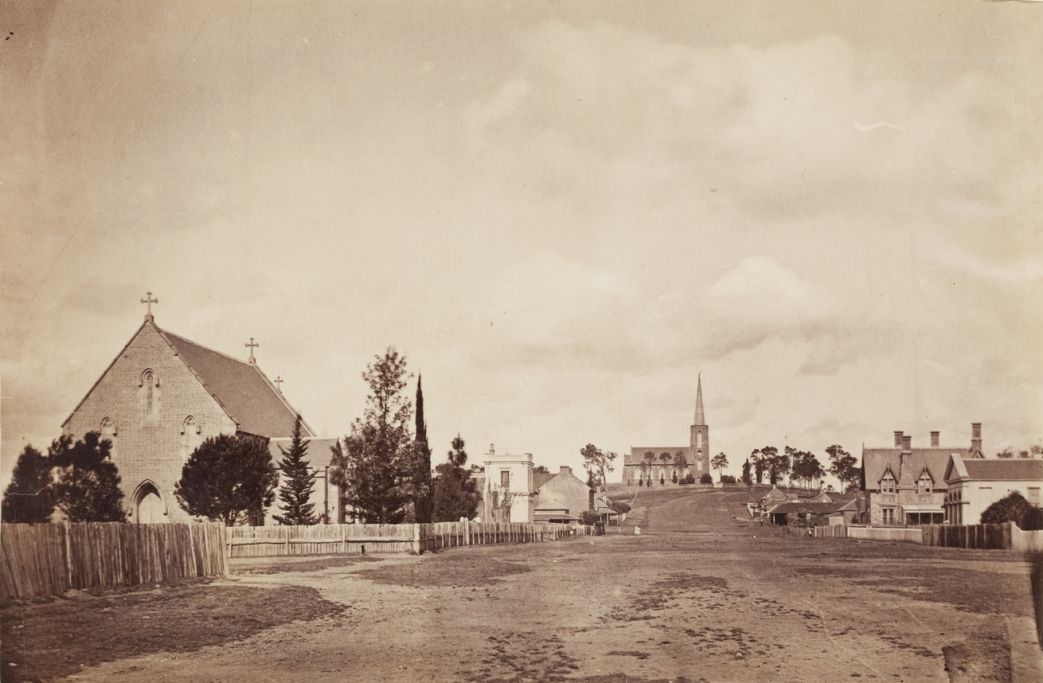
St Johns at top of John Street, circa 1860. From Album of views, reproductions of paintings, engravings and Macarthur family photographs, 1857-1866, 1879. Digital Order Number: a5906014, courtesy the Mitchell Library, State Library of NSW.
Overlooking the beautiful Nepean river, Camden, which, alike Pittwater, flooded last weekend, has many historic buildings and a real country feel, well worth visiting should you get a chance these coming July School holidays. John Macarthur, of Merino sheep fame, named his property Camden Park Estate in honour of Lord Camden the Colonial Secretary who had ordered Governor King to grant Macarthur 2,000 acres in the Cowpastures area.
Several TV series and movies have been filmed in Camden in recent years, "A place to call home" and Angelina Jolie's "Unbroken", being two many would have seen something of.
In April 2016 a stroll along John Street gave views of the Court House, at 31 John Street - In 1841 the local Court House was transferred from Cawdor to Camden and this piece of land was provided by the Macarthurs. Initially a lock up was built and it was extended in 1857 when this Court House and cells were completed. There is also Camden Police Station, 35 John Street - The town's police barracks and wooden house for the Chief Constable were built in 1878. Both were built on land that was provided by the Macarthurs who donated £100 towards costs. Gothic Revival archiecture can be seen in Macaria, 37 John Street a two-storey brick cottage characterised by stone trim, high chimneys, gabled windows and wooden fretwork on the verandas. Built in the late 1840s, for Henry Thompson who had built the first flour mill in the town, Macaria has been a grammar school and a doctor's surgery. Today it is the Camden Council Administration Building.
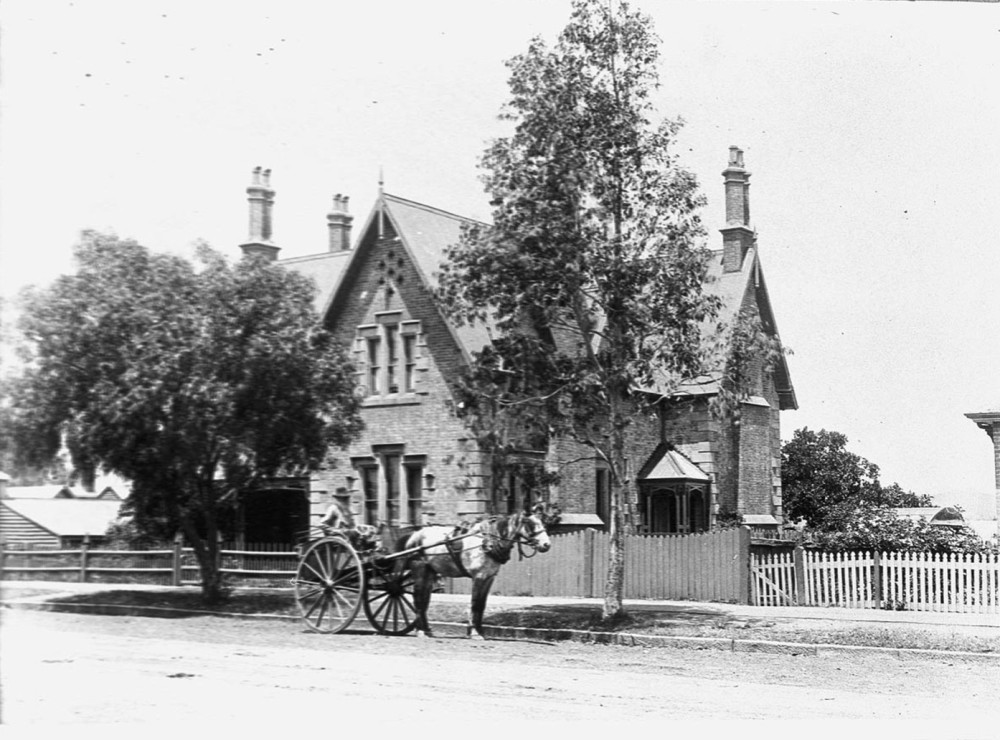
"Macaria", 37 John Street, Camden, 1900, Image No.: bcp_00105, courtesy Mitchell Library, the State Library of NSW.
Next door is Camden Cottage at 39 John Street a small Georgian residence built by Henry Thompson dating from the 1840s. This is thought to be the first home built in Camden and was once occupied by Captain William Larkin, the local mayor.
On the corner of John Street and Argyle Street is the Victorian Classical Revival NAB Bank building which opened in 1878. The intricate wrought-iron work on the balconies is original as are the medallions of Queen Victoria on the gates.
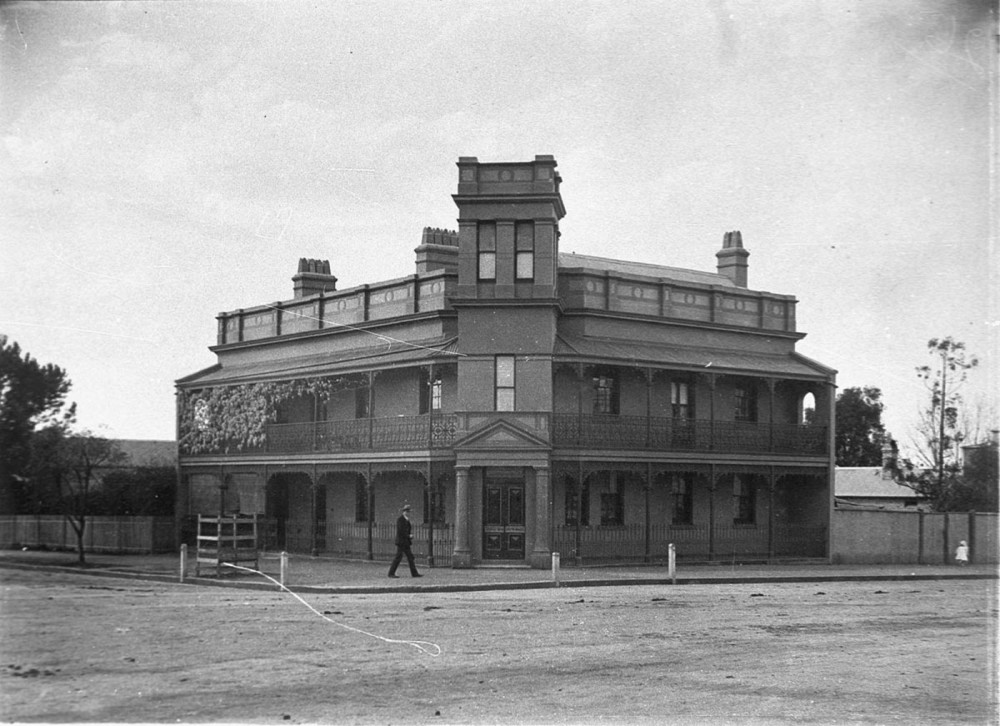
Bank of NSW, Camden, 1900, Image No.: bcp_00106, courtesy Mitchell Library, the State Library of NSW.
For those who love green spaces, Macarthur Park, located at the corner of Menangle Road and Park Street, Macarthur Park was opened on 10 October, 1906. Donated by Elizabeth Macarthur-Onslow, the grand-daughter of John Macarthur., this space It is noted for its beautiful gardens, sheltered picnic tables and amenities. The "shelter" was erected in 1913 as a memorial to Elizabeth Macarthur-Onslow who had donated 6 acres to the people of Camden in 1905 on condition that they be used for parkland, that no entry fee be charged, that no business be conducted on the land and that the timber be preserved. Some of the ironbarks are estimated to be 600 years old.
Overlooking Camden, and atop the hill John Street leads to is St. John's Anglican church. For those who love quiet spaces, for those who love churches, and some of us do always seek out these places of song and worship while visiting historic grounds, this is one not to be missed.
After the death of John Macarthur in 1834, the first registered land title for the new Camden township was for the nominal sale by his sons, James, second eldest, and William, a year junior. The brothers began clearing land for a township in 1835 asking those who lived there to contribute towards founding a church. By September 1835, £644 had been collected, with the majority (£500) coming from the Macarthurs.
The Macarthurs' plans for their church in the town coincided with the passing of Governor Bourke's Church Act of 1836 which promoted 'the building of Churches and Chapels and to provide for the maintenance of Ministers of Religion in NSW.' Church communities that raised a minimum of £300 pounds were subsidised on a 'pound for pound' basis up to a maximum of £1000. Additional land grants were also made available for churches and schools. Originally intended for Anglican, Catholic and Presbyterian denominations Bourke later extended the provisions of the Act to other denominations including the Jewish, Wesleyan and Baptist communities.
The full announcement from 1836:
" A Bill to 'promote the Building of Churches and Chapels, and to provide for the maintenance of Ministers of Religion in New South Wales." IN conformity to the principles upon which His Majesty's Government have been pleased to sanction contributions from the Colonial Revenue towards the support of public religion in this Colony, it is proposed to enact as follows :
1. That whenever a sum not less than .£300 shall have been raised ' by private contributions towards the building of a Church or Chapel,and Minister's dwelling, the Governor, with the advice of the Executive Council, to be authorised to issue from the Colonial Treasury any sum not exceeding the amount of such private contributions, to the extent of £1,000, in aid of the undertaking.
2. The Governor, with the advice of the Executive Council, to issue stipends to officiating Ministers at the following'rates, namely: If there be a resident population of 100 adults, subscribing a declaration of their desire to attend the Church or Chapel' of such Minister, £100 per annum. If 200 adults, £150 per annum. If 500 adults, £200 per annum.
3. If notwithstanding there be less than 100 adults the Governor and Executive Council to be authorised to issue, under special circumstances, a stipend of £100 per annum.
4. In places where there is no Church or Chapel, and there is reasonable ground for delaying the erection of the same, the Governor, with the advice of the "Executive Council, be authorised to issue any sum not exceeding £100 towards the stipend of a Minister, in aid of private contributions to the same amount, such contributions not being less than £50.
5. Trustees not less than three in number, to be appointed for every Church or Chapel by the private contributions towards the same Trustees not less than three in number, to be appointed for every Church or Chapel by the private contributors towards the same to which Trustees the real estate therein shall be conveyed, and who shall receive and account for sums issued in pursuance of this Act.
6. Free sittings to be reserved in every Church or Chapel, to the extent of one fourth of the whole, for the use of poor persons.
7. Trustees to be appointed for Churches or Chapels already elected. Colonial Secretary's Office, Sydney, 18th July. 1836. Government Gazette. (1836, July 23). The Sydney Gazette and New South Wales Advertiser (NSW : 1803 - 1842), , p. 4. Retrieved from http://nla.gov.au/nla.news-article2205627
Item 6 in this Act is interesting as people may not know that in the beginning of churches being established in Sydney people would 'rent' a family pew each year - a case of contention here comes in the 1828 affray between The Monitor editor, Edward Smith Hall, and the then Archdeacon of St. James Church of England, Thomas Hodges Scott. Mr. Hall was in the habit of using his pen to complain of many in the colony during the short time he ran the Monitor, and the quality of the Archdeacon's sermons filled a few columns. The Archdeacon took offense. On attempting to deny Mr. Hall access to his paid for pew,(£4 per annum) and family of many children, the matter ended up in court after a few Sunday skirmishes. Mr. Hall was 'evicted' from his rented pew, the best pew in that house of the Lord at that stage, apparently. A little crowing by the Archdeacon at his small victory caused the matter to head back to court a second time.
During this 'case' Mr. Hall, quite rightly, pointed out that the church had been authorised by Governor Lachlan Macquarie, had been drawn in plans by a convict and raised by convicts and that the King, not the Church of England, owned said St. James, therefore Archdeacon Scott was the trespasser, not he. See: Supreme Criminal Court. (1828, October 1). The Sydney Gazette and New South Wales Advertiser (NSW : 1803 - 1842), , p. 2. Retrieved from http://nla.gov.au/nla.news-article2191122
The Archdeacon threw in the towel in Sydney in November 1828 and returned to England in October 1929. Mr. Hall subsequently made Governor Darling the target for his criticisms and ended up in goal, unable to pay fines from libel cases the same year (1929). The Governor released him in 1930 when King William IV ascended the throne, as was the custom then. Mr. Hall retired from 'journalism'.
James and William Macarthur applied for a subsidy of £1,000 toward a total cost of £2,500 pounds. The appointed trustees of the new church were Rev Thomas Hassall, Charles Cowper of Wivenhoe, James and William Macarthur, and George Macleay of Brownlow Hill. Plans were drawn in 1837 by James Hume of Sydney for a "classical style" building.
By the winter of 1840, as shown in this proposal or the Village of Camden, and subsequent land sale notice, construction had commenced:
PROPOSED VILLAGE OF CAMDEN.-We have been granted by the inspection of a design for are the proposed Village of Camden, the site for which has been most eligibly chosen on the able Land which overlooks the Nepean River, immediately in the vicinity of the Cowpasture Bridge, on the present line of the Razor Back Road. ON the greatest elevation of the adjacent hills, it is proposed to erect a Church, the situation of which will be highly picturesque and commanding, and in the plain below nearest to the new line of road, traversing the intended Village, did the wealthy proprietor will forthwith communicate and the erection of a first-rate commodious hotel, for the reception of respectable families and travellers an acquisition of the greatest importance to this part of the Country. The village allotments, one hundred in number, each contains half an acre, and they will be well suited for the erection of cottages and dwellings the resident mechanics and working tradesmen, for whose services, in this district, there is always ample remuneration. The Nepean River winds around the segment of a circle, within which the site of the village has been chosen, so that fresh water in the greatest abundance is in the immediate vicinity. Every consideration of salubrity and convenience appears, in short to be combined in the choice of the situation which has been made, whilst the lie of this part of the country, and its well-known fertility, cannot fail to impart additional value to the village allotments, whenever brought forward for sale, which we understand, will shortly be the case - Herald. News of the Day (1840, February 17). The Sydney Monitor and Commercial Advertiser (NSW : 1838 - 1841), , p. 2 (MORNING). Retrieved from http://nla.gov.au/nla.news-article32167228
Camden Estate and Township. TO BE SOLD BY AUCTION. MR. SMART HAS received instructions from the Proprietors, James and William Macarthur, Esqrs., to offer for Public competition, on an early day, (which will be named as soon as the survey now in progress is completed,) a portion of the well-known Camden Estate, situated in the fertile and centrical District of the Cowpastures, only forty miles from Sydney, thirty from Parramatta, twenty from Liverpool, eight from Campbelltown, and from two to four from the now rising Township of Camden, adjoining the Cowpasture Bridge, and on the Great South Road to Berrima, Goulburn, Yass, Melbourne, &c., &c. The portion to be disposed of consists of 2000 acres, bounded on the south by Cawdor Estate, the property of the Messrs. Macarthur; on the east and on the north by the Nepean River, which separates North Camden from the Estates of the Hassall family, Charles Cowper, Esq., Mr. Blackman, and other residents in the thickly-settled district of Cobbetty, and on the west by Hunter's rivulet, which separates it from Brownlow Hill, the beautiful property and residence of George Macleay, Esq. North Camden will be divided into between thirty and forty Farms of convenient size, of which two-thirds will have extensive frontages to the Nepean River, and the remaining third to Hunter's Rivulet, and another water course intersecting the Estate; besides which un-reserved roads will afford easy access to the Nepean River, from all parts of the property, and no farm will be more than a mile from a public watering place on that river, which has never ceased to flow in the driest seasons and the water of which is celebrated for its purity. The beauty of the scenery, richness of the soil, and other advantages of the Cowpasture District are too well-known to require comment. For the information, however, of newly arrived Colonists, it may be well to notice that five acres of land in the Cowpastures may be cleared and brought into cultivation with less trouble and expense than one acre at Illawarra. The farms now offered for sale will be found admirably adapted for homesteads and residences of gentlemen having Grazing Establishments in the Southern Counties, or for the Dairy, the rearing of pigs and poultry, the growth of tobacco, wheat, maize, and millet, as well as Lucerne and other grasses for hay; and for the formation of Vineyards, Orchards, and Gardens, whilst, being in the immediate vicinity of the Township of Camden, and within easy distance of Sydney, Parramatta, Liverpool, and Campbelltown, the purchasers will at all times command markets for their produce. A Water Mill is about to be erected on the Nepean River, immediately adjoining North Camden, and in further proof of the rapid increase of population, and improvement of the surrounding districts.Churches are now building at Cobbetty and Camden, on a scale sufficient for the accommodation of numerous congregations.Immediately after the sale of the North Camden Farms, Mr. Smart will bring to the hammer several Allotments in the Township of Camden. The Terms and conditions of sale, which will be liberal, will be made known with further particulars in a future advertisement, after the completion of the survey. Printed at York-street, and Published at George-street, Sydney, by the Editor and Proprietor, FRANCIS O'BRIEN. Advertising (1840, June 5). The Sydney Monitor and Commercial Advertiser (NSW : 1838 - 1841), , p. 4 (MORNING). Retrieved from http://nla.gov.au/nla.news-article32183408
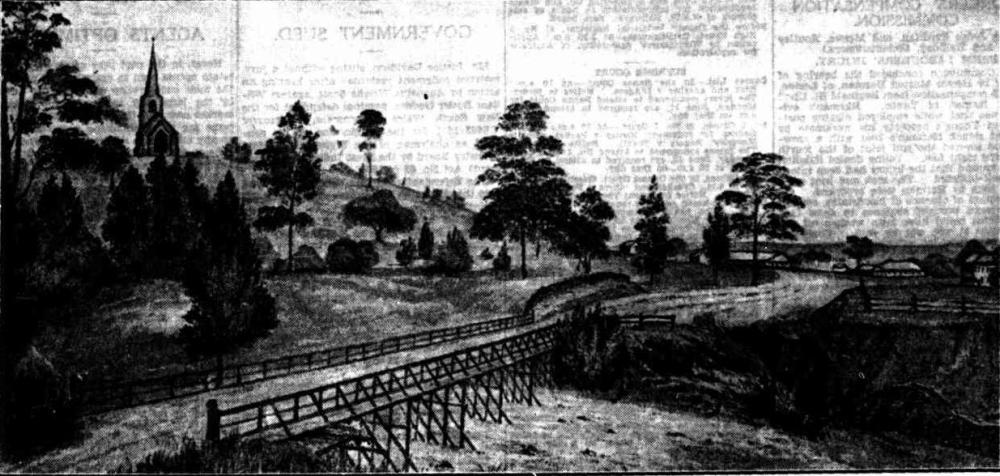
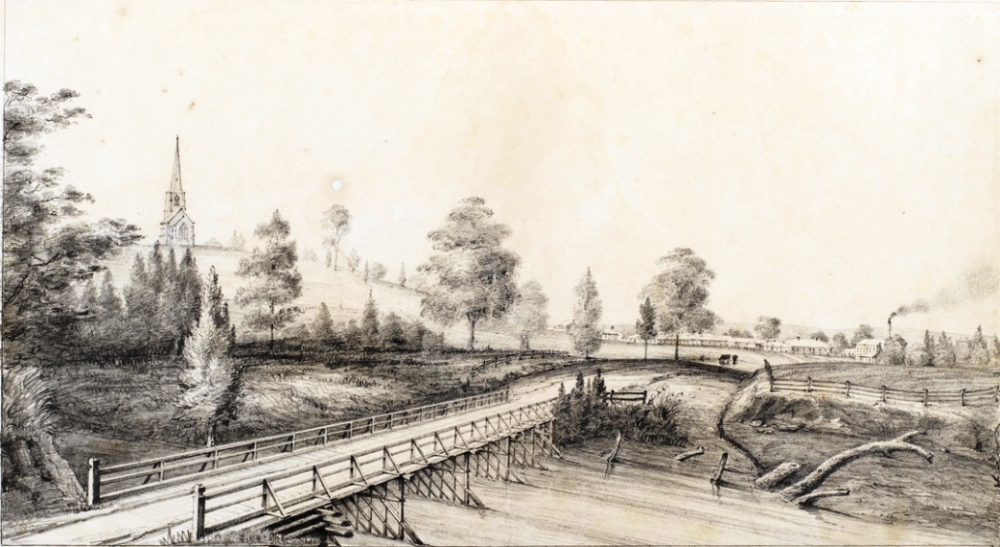
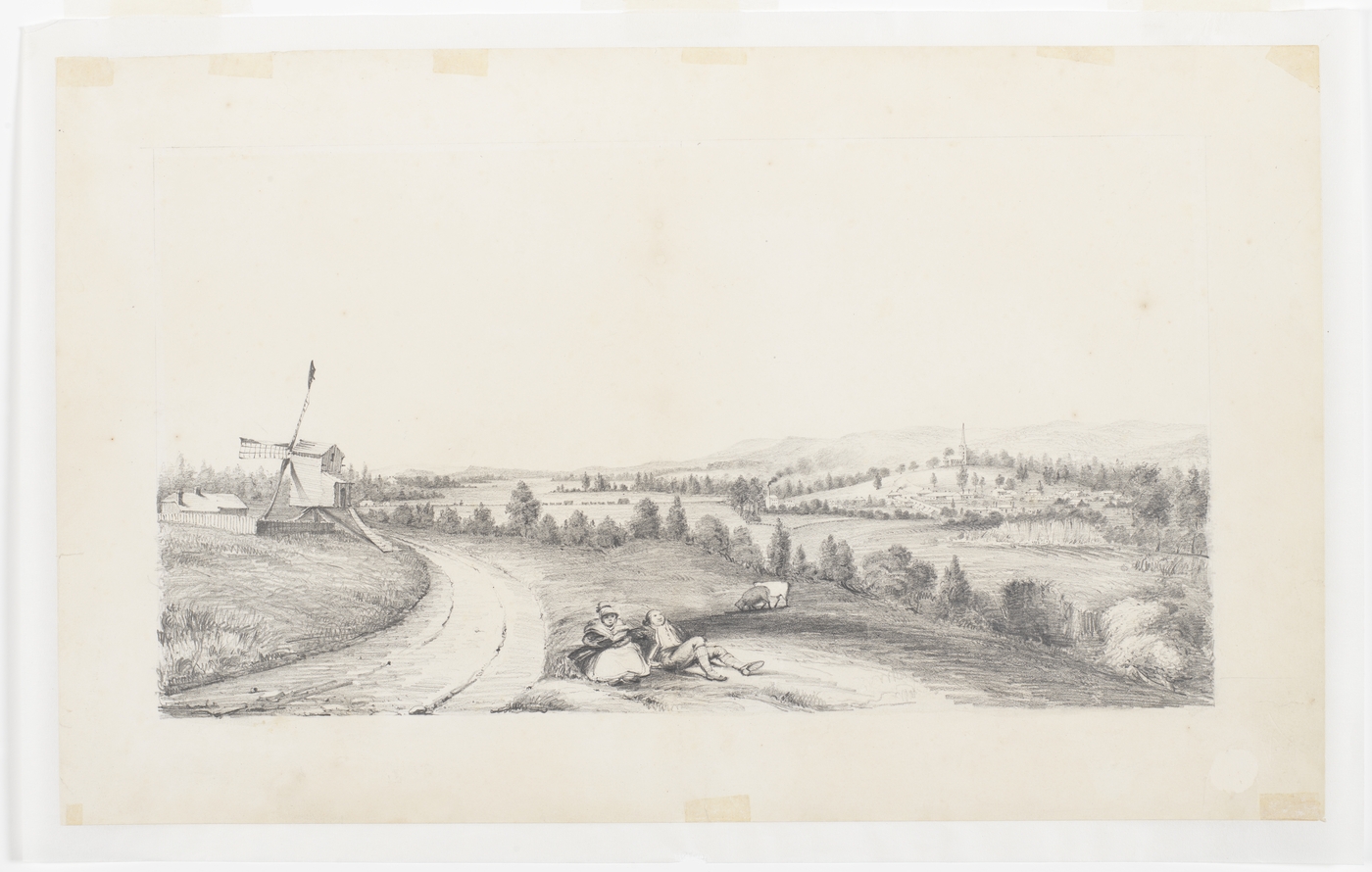
In May 1841 the land grant for the church of 5 acres 3 roods and 24 perches was registered between James and William Macarthur and Bishop Broughton. The deed reserved the land for the purposes of 'the erection of a church or chapel for the performance of divine worship according to the rites of the United Church of England and Ireland (and) for the erection of a residence for a clergyman in holy orders and for a burial ground according to the use of the said United Church.' The church grant was bounded on the east and south by a road from Elizabeth Street to Camden House, and on the west by a road leading from Broughton Street to Camden House. The grant deed also included 2 perches of land that is the Macarthur family burial vault.
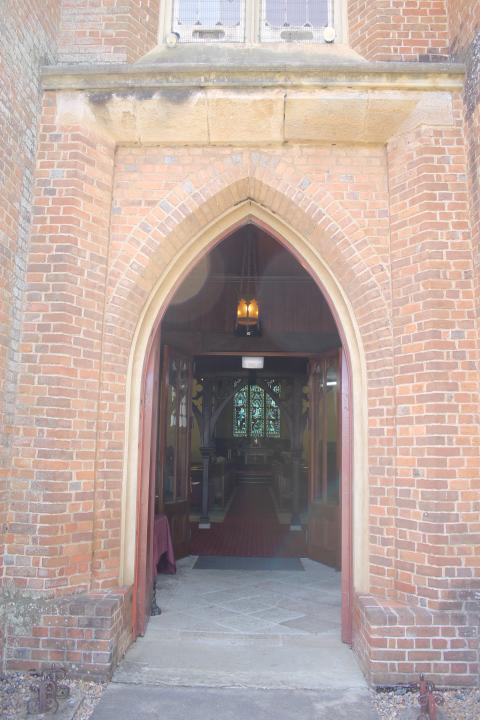 The St John's church records make no doubt as to the identification of the builder: Richard Basden, whose brickyard (situated on the south-west junction of Argyle Street and Oxley Street) supplied the 386,000 bricks used in the church's construction. Basden also built two other prominent buildings in Camden, the post office and the inn. Some records indicate that Mr. Basden did not want the church's bricks copied and had the pit from which they were drawn filled in after the walls were completed.
The St John's church records make no doubt as to the identification of the builder: Richard Basden, whose brickyard (situated on the south-west junction of Argyle Street and Oxley Street) supplied the 386,000 bricks used in the church's construction. Basden also built two other prominent buildings in Camden, the post office and the inn. Some records indicate that Mr. Basden did not want the church's bricks copied and had the pit from which they were drawn filled in after the walls were completed.
The roof framing of ironbark was given by the Macarthur brothers, being cut from the forest at Mount Hunter by Jonathon Wheeler.:
Mrs. Samuel Wheeler, the oldest parishioner, preserves an interesting link with the past. Her husband came to Australia with his father, the late Jonathan Wheeler from Gloucester, in 1838. The Wheelers were sawyers. They were brought out by the Macarthur family for the purpose of preparing the timber for St. John's Church. The finest of the ironbark trees in the district were placed at their disposal. How splendidly the Wheelers, father and son used their material, can be seen in the roof of the church today nearly a century later.The woodwork throughout St. John's has been handled with exquisite craftsmanship. Samuel Wheeler died in 1909, aged 94. His widow, though now in her 90th year, still walks up the hill to service. Another of St. John's beauties is its brick-work. Lovers of this almost lost art always admire it. The bricks were made in Camden, not far from the church. It is said that the builder Richard Barsden, ordered the excavations to be filled in when he had sufficient bricks made for the building. ST. JOHN'S, CAMDEN. (1933, June 10).The Sydney Morning Herald (NSW : 1842 - 1954), , p. 9. Retrieved fromhttp://nla.gov.au/nla.news-article16978921
The brick spire, the framing and other timberwork were constructed by John Le Fevre, also a church warden, in 1854. The window stone tracery and the floor flagging were cut from a local quarry, the cusped hammerbeam roof trusses were cut from local ironbark trees. The roof was built by people imported from England by the Macarthurs. The design here introduces the influence of Edmund T Blaclket for the first time:
Camden Church is now roofed in, and the stuccoing of its towering spire is being proceeded with, and will soon be ready as a place of public worship. The site is the gift of Mr. James Macarthur, who has in addition subscribed most liberally (report says £1500) towards defraying the expenses of the erection. BERRIMA. (1842, March 21). The Sydney Herald (NSW : 1831 - 1842), , p. 2. Retrieved from http://nla.gov.au/nla.news-article12874315
OPEN ROOFS.—We are glad to see that open roofs are being introduced into the Ecclesiastical buildings of this colony. Those who have seen the glorious interiors of the ancient Churches (particularly those of Suffolk) and Halls of England, well know how to appreciate this kind of structure, which while it is less costly than the usual heavy timbered flat and ceiled roofs, is infinitely more effective in appearance and suitable to a warm climate like this. Good material in the principal timbers, and abundant thickness of wall or buttress are the chief requisites to their proper construction. The many works on architecture now issuing from the English press will furnish abundance of examples to the colonial architects. Mr. Edward Blacket must have the credit of introducing the open roof into more general use and notice in this Diocese, and we need only refer to the School houses of St. Lawrence and St. Andrew's Parishes, to show how successfully this kind of structure may be applied. Some other examples will also be found in the Church at Camperdown, and in the School-house at Balmain, when completed. We must not omit, however, to mention that at the St. James's Grammar School, which was designed by Mr. Hume ; and we understand there is a similar one at the St. Leonard's Church, on the North Shore, by the same architect. We only regret that this church was not of a more Ecclesiastical character. Why was not its excellent work and material which it exhibits, thrown into the Norman style, instead of the anomalous " Macquarie Gothic" which it now presents to view? We had nearly forgotten to name the open roof at Camden Church, built by the Messrs. Macarthur, which is exceedingly beautiful and well proportioned. We draw attention to this sub-ject, in the hope that it may be pursued, and we shall be very glad if our columns can be used for the diffusion of information upon it. It is really a shame that with our excellent materials for building, and the numerous architectural appliances that England now furnishes, this Diocese would be wanting in good Ecclesiastical buildings ; and the more so be-cause propriety of style and construction does by no means involve additional costliness, indeed, rather the reverse, for utility and simplicity are the chief characteristics of sound and pure Ecclesiastical buildings ; of course, there is always capability for decoration also; but a building, if properly designed, is not incomplete without decoration.—Southern Queen. Family Notices (1845, May 7). The Sydney Morning Herald (NSW : 1842 - 1954), , p. 2. Retrieved from http://nla.gov.au/nla.news-article12879289
CAMDEN.
SWEET scents and verdant prospects greet us at every step. We repose in sheltered verandahs inhaling the smell of orange flowers-it is the bridal of nature, who from her treasury of fruits and blossoms, scatters her wedding favours with the hand of happy profusion. Wherever we turn, loveliness delights the eye ; and the changes are only from positive to com parative and superlative. In sober plainness, we have never experienced a more wondeiful change from gloomy to cheerful ; and at pre-sent we can enjoy all this enchantment, for the mosquitos and other sting insects, usually very troublesome at this time of the year, have not yet paid us their visitation ; but we must not boast, for doubtless come they will, to remind us that there is no perfect happiness in this world. The ladies appear to be of this opinion at any rate, for we see them cheapening gauzes and other light fabrics for curtaining their pillows, and warding off those flying pests, whose villanous whining is almost as fatal to slumber as their sting.
As might be supposed, the maize continues to thrive, and so do the weeds-and very lazy farmers let them both grow together, and "chance it" as the phrase is; more careful ones endeavour to keep the weeds down, if not altogether, at least from the corn-hills, and verily to all appearance these have their re-ward. On the hills between this and Campbelltown, we perceive that some of the settlers are actually sowing oats for hay, aye, and get-ting in the seed in real agricultural style too. Tobacco has never, we think, been cultivated in this part of the country ; some of the rich bottoms near this village appear to us admirably adapted for it-at any rate they produce " fat-hen' in great profusion, and that is a good criterion ; it is, however, a poor compliment to the idle farmers who do not half cultivate these highly fertile lands.
The early fruit is now nearly gone, it has been beautiful to the eye, but having been forced into a state of unnatural plumpness very suddenly by the rains, it has little or no flavour. Some of the peaches and nectarines from Camden and Wivenhoe gardens were very rosey and tempting ; peaches were selling in the village for 2d. per dozen; grapes at 2d. per pound. The flying foxes' (a kind of bat as large as a hen) have made great havoc among the early peaches-the second crop will soon come in, but it will be a scanty one.
The weather has been just such as farmers wish for-nothing could be more calculated to foster the growth of vegetables, and we may add nothing could be more salubrious; we have had no hot weather during the last week, and every day a pleasant breeze, with now and then a small shower ; murmuring thunder high overhead in the morning, and two days, Friday and Saturday (28th and 29th) decidedly cold, wind east.
Our new clergyman has arrived, it is to be hoped that'We shall now have Divine Service, according to the forms of the Church of England, in the village of Camden itself, instead of its environs. Here are the walls of as noble a church as man in the colonies could be expected to rear ; and this all done, as far as individual exertions have gone, by one family. Can the inhabitants for very shame, now suffer it to remain unfinished Time will tell. It is completed all to the pulpit and seats and chancel fittings.CAMDEN. (1848, February 4). The Sydney Morning Herald (NSW : 1842 - 1954), p. 2. Retrieved from http://nla.gov.au/nla.news-article12892636
The economic agricultural depression of the 1840's set back construction, delaying consecration by Bishop Broughton to June 1849, although the final cost, as recorded in some research, of £8000 after all the works were done by the mid 1870's, may have been a factor too - and the church still wasn't complete on opening! One of the reasons the church took time between completion and consecration is noted here, along with the 1849 reports of this Happy Day:
ST. JOHN'S, CAMDEN
Sir,-The author of the article, "Down to Camden Town," states that St. John's Church "will be 100 years old in 1949." I must point out that the Church of St. John, Camden, was begun in 1840, and celebrated its centenary in 1940. However, the consecration took place in 1849, and we are looking forward to the centenary celebrations of this event in 1949. As a matter of general interest it may be stated that many churches are dedicated, but not consecrated until complete, fully furnished for divine worship, and free of debt. In Camden this was achieved within nine years. A. H. KIRK. Rector of St John’s, Camden. ST. JOHN'S, CAMDEN (1946, November 14). The Sydney Morning Herald (NSW : 1842 - 1954), , p. 2. Retrieved from http://nla.gov.au/nla.news-article18002593
CAMDEN
Thursday, May 31.-We have much pleasure in informing you that it rained heavily during the whole of last night-and that it still rains, with an appearance of continued wet. This rain is warm, and favourable to vegetation, although coming at a time of the year when vegetation is generally torpid. The fields have had already a good soaking, and the showers now falling are steady and gentle, and will therefore continue to penetrate without running off.
St. John's Church.-I am glad to be able to inform your readers that the fittings of our new Church are so far completed, that the Lord Bishop of Sydney has fixed on Thursday next, (June 7,) as the day on which the ceremony of consecration shall take place. The increasing population of this village and neighbourhood has long rendered it desirable that the Church should be opened for divine service. CAMDEN. (1849, June 5 - Tuesday). The Sydney Morning Herald (NSW : 1842 - 1954), , p. 3. Retrieved from http://nla.gov.au/nla.news-article12914278
NEWS FROM THE INTERIOR. (From our Correspondents.) CAMDEN.
June 7-As faithful chroniclers of passing events, it is now our pleasing duty to announce that the long-desired consecration of St John's Church, in this village, took place to-day. At in early hour the inhabitants of the neighbouring farms mid villages began to direct their steps toward» the beautiful edifice, which stands in bold relief on an eminence affording one of the loveliest prospects m this part of the country. The pedestrian-the horseman and lady rider too-the passenger by cart, gig, and phaeton-dotted the hill and its acclivity pretty thickly by eleven. Shortly after which the Lord Bishop of Sydney arrived from Camden Park, where he had passed the previous night. By this time the church was filled to over-flowing, by not only the actual residents, but many kind neighbours from Campbelltown, Picton, and Cobbity, as well as visitors from Windsor, Sydney, and other distant places. His Lordship was received, as is usual, by several of the principal inhabitants, including, of course, Mr. James and Mr. William Macarthur, to whose paternal liberality the public are principally indebted for the church itself. The petition for consecration, on having been read, the Bishop, accompanied by the clergy, proceeded to the chancel, repeating alternately the 24th Psalm. There was a large number of clergymen present, among whom we noticed the Rev. Messrs Bobart, Forrest, Troughton, Stack, Watson, Sparling, Stiles, Walser, Hassall J Hassall, Walsh, Wilkinson, Vidal, Macarthur. and the incumbent, the Rev. E. Rogers After the solemn and impressive service was gone through, the Bishop delivered an excellent sermon from Gen xxviii 16, "Surely the Lord is in this place," which was succeeded by the Holy Communion, of which about forty persons partook. The collection at the door and the altar together amounted to £13 l5s.,-the congregation numbering above five hundred. We have been at the consecration of several country churches, but never saw so large an assemblage before on such an occasion
We hope some abler and scientific pen will afford you an architectural description of the building. Meanwhile, we may remark, that it has a bold and lofty spire, "which like the beacon of hope on the undulating wilderness of life, may be seen from many a distant hill", and, exclusive of the basement of this and the chancel, covers an area of about 70 feet by 40. The walls seem to be some 35 feet high, from the summit of which springs the beautifully arched ceiling, tastefully constructed of carved wood alone. This vaulted formation of the roof gives the interior a very noble appearance, somewhat approaching to sublimity, and quite congenial to devotional feelings. The windows are of ground glass, jewelled tastefully with variegated studs at the intersection of the panes, with the exception of the great window in the chancel, which is composed almost entirely of variegated panes. The interior of this fine building will require more money to finish it than the times afford, although the heart be willing, and, therefore, many of the fittings have been temporarily got up, as cheaply as possible, to admit of the performance of Divine Service without further delay. But the Font is a permanent work, very artistically executed, and presented to the church by Mr. William Buchan, a talented mason and sculptor from Scotland, residing in this village. It is a handsome present for a poor man, and does his zeal for the cause great credit The stone was obtained from a quarry at Danbigh, the estate of the Rev. J. Hassall, and the design was furnished by Mr. Lewis, the Colonial Architect.
After the consecration of the Church, the burial ground was consecrated, when the assembly dispersed at nearly three o'clock.
The weather was as propitious as could have been desired, all Nature seemed to smile upon us, and the bright gleam of sunshine which fell as we were leaving the churchyard, will long shed a halo over recollection, and characterising this as the fairest holiday which has ever blessed the rising village of Camden. NEWS FROM THE INTERIOR. (1849, June 11). The Sydney Morning Herald (NSW : 1842 - 1954), , p. 3. Retrieved fromhttp://nla.gov.au/nla.news-article12905068
A report from a few weeks later records the outfitting of the interior in a reprise article of 1909:
' The congregation at the Camden church on the two Sundays since its consecration, has numbered two hundred or more: this is very well. Since that day the railings of the Church have been put up; they are very handsome and accord with the architecture of the building— the balustrade being intersected by carved Gothic arches. We understand that the Bishop has generously contributed more than half the expense of this work. His Lordship has also very kindly assisted our wants by sending up a number of convenient cedar seats; the permanent seats (which are intended to be open) will be put in hand as soon as there are funds, as also the pulpit, which is to be of the beautiful colored freestone of this part of the country, obtained at the quarries of Mr. George Macleay, of Brownlow Hill. In giving an account of the opening of the Church, which it will be remembered was on 7th June inst., we omitted to mention as entirely accidental coincidence which is worth remarking. On that very day forty-four years, viz., on 7th of June, 1805, the late Mr. John Macarthur, the father of the gentleman who gave the site, and mainly raised the Church, returned to the colony from England with the first merino sheep, thereby laying the foundation of whatever prosperity it has hitherto known.
' We furnish, according to promise, a few more particulars respecting the architectural features of this handsome structure. It consists of a nave, chancel, and western tower and spire, all, including the spire, being built of brick, and at some future time to be covered with plaster the spire is already stuccoed. The windows, which are of the decorated' period, are exceedingly well wrought in the stone procured from the neighbourhood, which is of a greyer color and closer grain, though softer in the cutting, than the sandstone around Sydney. The flagging of the interior is the very best piece of work of the kind in the country. The roof is open, with the beams and spandrils. The windows are filled with fancy patterns of octagon and square glass ; the former being ground, the latter colored, set in copper frames. The alter rail is carved with cinquefoil pointed arches, on small shaftes, with caps, bases, and bands, in the style of the church. and is of very rich effect There is a want of porch and vestry,. and the chancel is far too short. With these exceptions all is satisfactory, and evidences the spirit of reverential care and true devotion which we must always rejoice to see manifested in the erection of God's house of Prayer. — The Sydney Guardian.Consecration of St. John's Church, 1849. (1909, June 17). Camden News (NSW : 1895 - 1954), p. 1. Retrieved from http://nla.gov.au/nla.news-article136643958
These original seats are still in the church, although they have been 'updated':
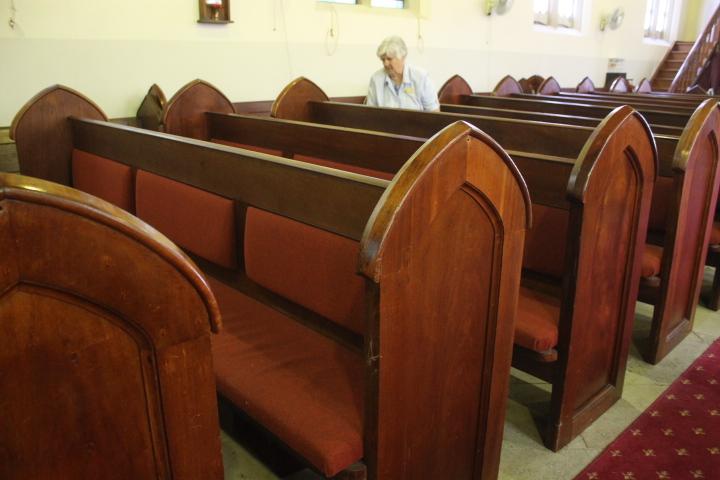
A structure this old had further adjustments, especially regarding the 'chancel being far too short':
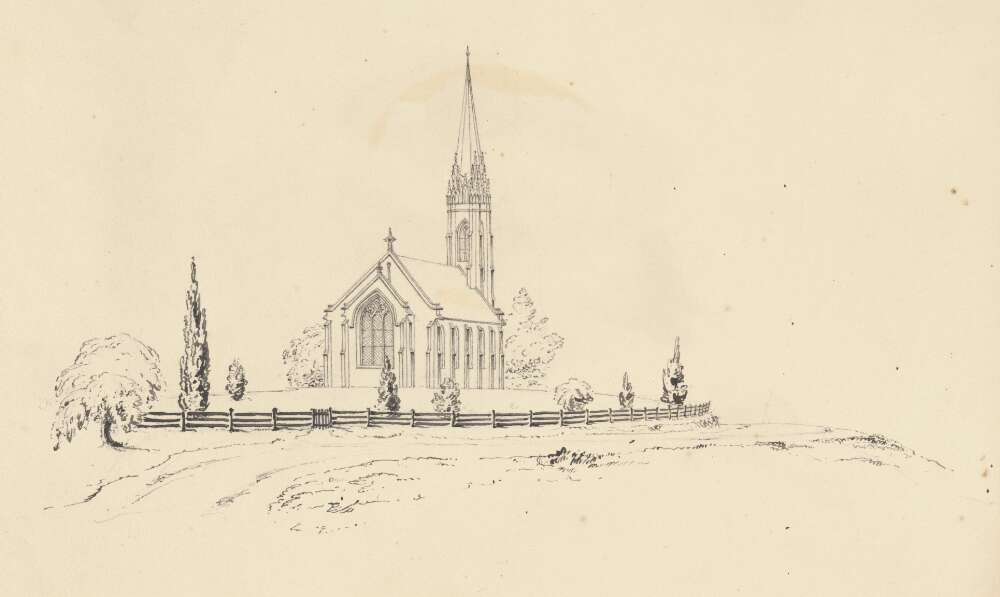
St Johns Camden 1850 - Image No.: nla.obj-142811908-1, courtesy National Library of Australia: showing shallow chancel and ironwork at base of spire tower
In 1857 the by then Sir William MacArthur (due to his work in representing Australia in the Exhibition for all Nations in France - see Extras) commissioned English Gothic Revival architect Sir George Gilbert Scott to provide plans for a brick chancel, nave and vestry addition. Some records indicate Mr. Blacket was also asked to provide drawings while others state the works were supervised by the then Sydney architect Edmund Blacket.
In church architecture, the chancel is the space around the altar, including the choir and the sanctuary (sometimes called the presbytery), at the liturgical east end of a traditional Christian church building. It may terminate in an apse.
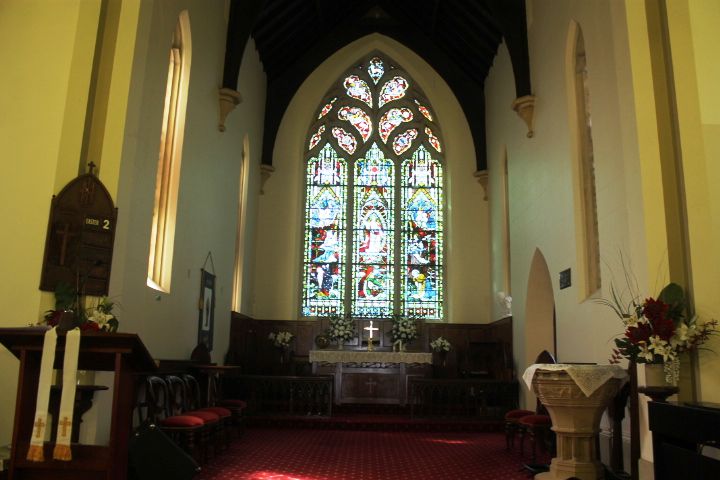
What seems certain is that Edmund T Blacket oversaw the final stages of the construction of the church - the earlier roofing inspired buy his designs, if not his drawings, and the extensions.
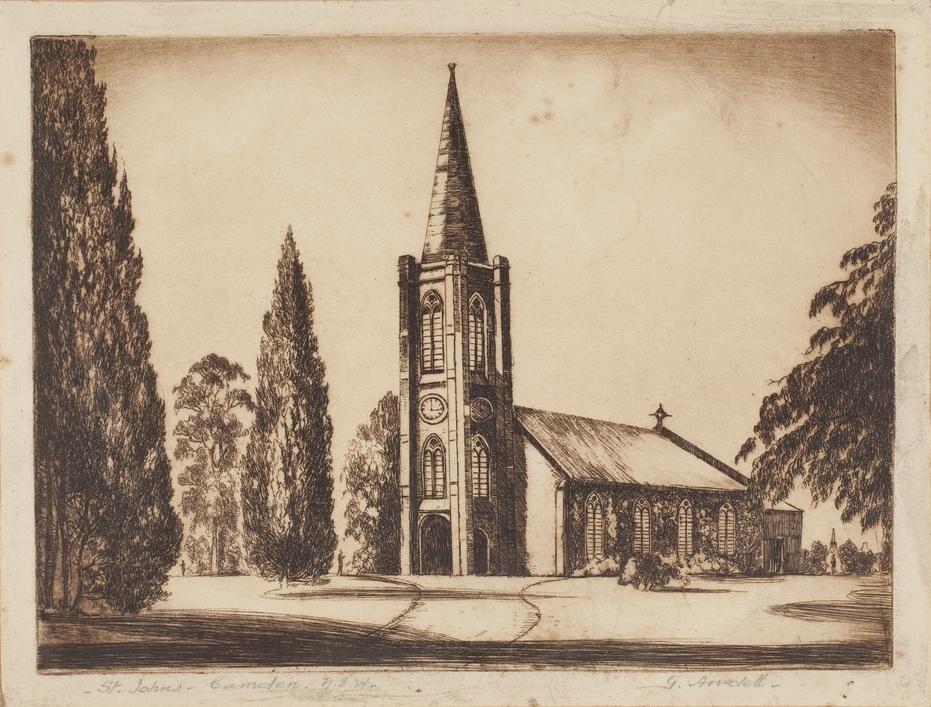
St John’s Camden, N.S.W. by G. Ansdell Image No.: a2423021 from Macarthur Family miscellaneous photographs and prints, circa.1862-1915,courtesy Mitchell Library, State Library of New South Wales: showing a changed spire and clock.
The Church now has many fine dedicated stained glass windows, the earlier ones are from England, and include two remaining of the original design; later windows are of local design. The prominent east window (Clayton and Bell, London) was installed in 1874 and depicts the Transfigured Christ framed by a Latin inscription "This is my Son—my Chosen—Listen to Him".
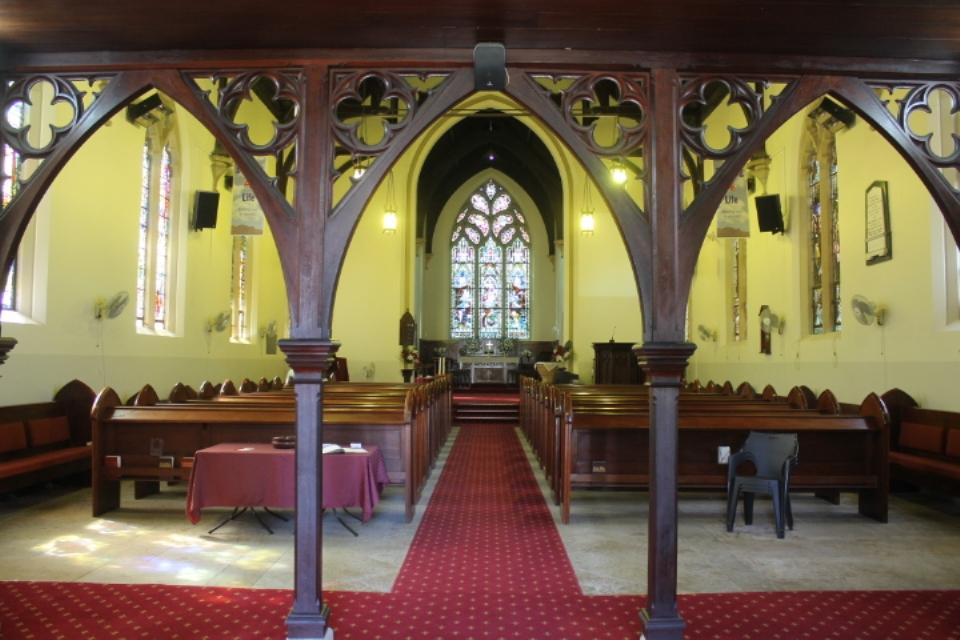
The Organ made c. 1860 by Bates & Son in London is single manual with tracker action, seven ranks of pipes and was originally hand pumped. It is housed in a delightful gothic case having gabled towers with pinnacles and is the only Bates organ in NSW. The organ has been recently fully restored.
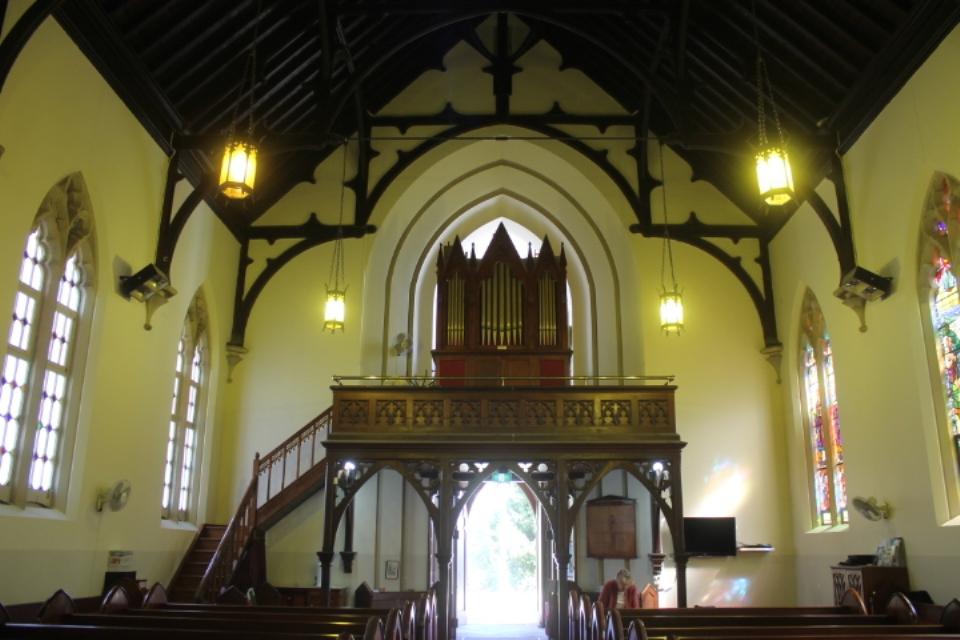
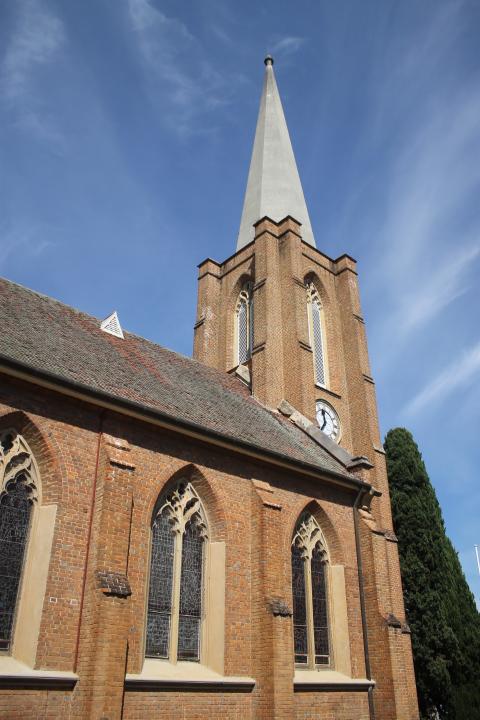 The Clock and Bells were dedicated in 1897 as a gift from Elizabeth Macarthur-Onslow. The chiming clock with three 1.8 m dials and 1.5 m long bed frame was made by Gillett & Johnston of London; originally hand wound but now automatically by electric motors.
The Clock and Bells were dedicated in 1897 as a gift from Elizabeth Macarthur-Onslow. The chiming clock with three 1.8 m dials and 1.5 m long bed frame was made by Gillett & Johnston of London; originally hand wound but now automatically by electric motors.
The Peal of 8 bells, the largest weighing 710 kg, was made by Mears & Stainbanks of London. The bells can be played by two hands pulling numbered ropes on an "Ellacombe" frame.
The Cemetery on the southern slope of the church site contains many historic graves and memorials.
Memorial Gifts
In the west entry and in the building there are a number of wall plaques and smaller engraved labels attached to furnishings relating to persons and events.
In the Church
The church History Panel at the entry was given in 1952
- The Communion Rails were given in 1850 by Bishop W.G. Broughton
- The Communion Table and Reredos behind were presented by the parishioners in 1917 to mark 25 years of ministry by Rector Rev C.J. King
- The Panelling of wood on either side of the Reredos was given in 1970.
- The two large wooden Chairs either side of the chancel were given in 1874
- The Prayer Desk was presented in 1905 by the ladies of the parish.
- A Silver Communion Flagon was given in 1872 by the Rev. H. Tingcombe on his leaving the parish.
- The later Silver Communion Flagon and Goblets were given in 1974 in memory of the Cranfield family.
- The Communion Set in a small oak travelling case, was used during World War 1 by Brigadier-General G.M. Macarthur-Onslow in Egypt and Gallipoli.
- The Alms Dish in brass with silver eagle, sun and grapes decoration, was given by Anne Thompson born in 1940, for the 99th Anniversary of St. Johns foundation.
- The Processional Cross was given in 1930.
- The Font of local stone was made and presented c.1850 by the stonemason, William Buchan.
- The Lectern in the form of an eagle, carved from Burmese teak, was purchased in London in 1894 as a bequest.
- The Holy Bible on the eagle lectern was given in 1969.
- The elevated cedar Pulpit was given in 1858 as a bequest from a Dr. Anderson.
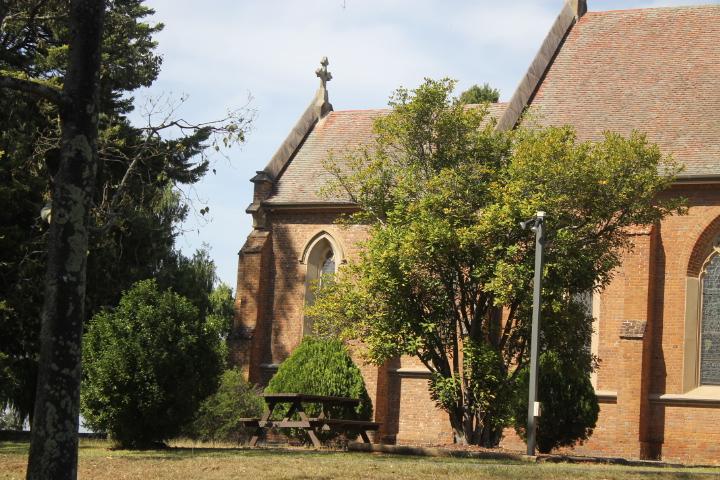
In the Grounds
- The Lych Gate and Picket Fence at the Menangle Road entry to the grounds was given in 1912 as a memorial to Mrs Elizabeth Macarthur-Onslow.
- The Gates and Boundary Fencing of some 550 meters, were given in 1935 by Mrs. Faithful Anderson.
- The flight of Steps and iron Railings leading up from John Street were given in 1935 by General J.W. Macarthur-Onslow.
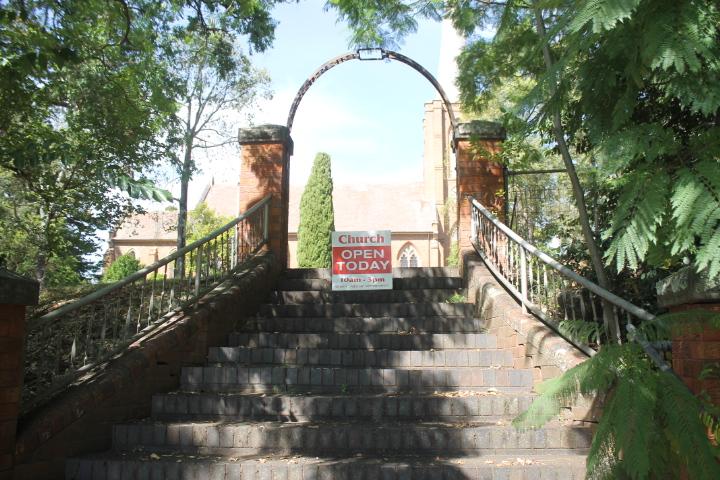
- The electric Luminaire specially was made of copper, was erected over the steps, in 1935 as a memorial (now lost)
- The Sundial originally made for Riley's property at Glenmore in 1861 was purchased in 1922 by Brigadier-General G.M. Macarthur Onslow and subsequently donated to the Church in 1953, and recently fully restored.
Private inner conversations with God, with a capital ‘g’, Buddha, with a capital ‘b’ or ancienter Elohim, Elaha or Allah, capitalised too into being a name, cannot be communicated although these are a universal moment by moment dynamic for billions. Joining in chants, prayers, and hymns, sutras spoken aloud are outer echoes of inner feelings alike those of being at home as soon as you hear rhythms in waves reaching shores, or the pure trill in birds and even laughter that all also communicate and encase what cannot be heard, but has filled these things nevertheless.
The range of manifesting these inner joys is seen in many guises. Prevalent among these are the temples, the churches. Reflecting the architectures of the ages they sprang from, therein speaks a Voice of joy, peace and human empathy that is shared with all other humans and creatures, whatever your denomination. It too may seem silent but is palpable in these wonderful structures and the spaces they enfold.
To the M'Arthur family this was something they too wished all who wanted it to have access to, as indicated in this, in that although Anglican, John M'Arthur wished everyone to have their own church, and later, his sons kept to this chance for all to have such places for peace:
John Macarthur, Esqr., has kindly offered sufficient land in the vicinity of the Nepean, for the erection of a Roman Catholic Chapel and Chapel House, and an adjoining plot for a burying ground. DOMESTIC INTELLIGENCE. (1832, February 27). The Sydney Herald (NSW : 1831 - 1842), , p. 3. Retrieved from http://nla.gov.au/nla.news-article12844162
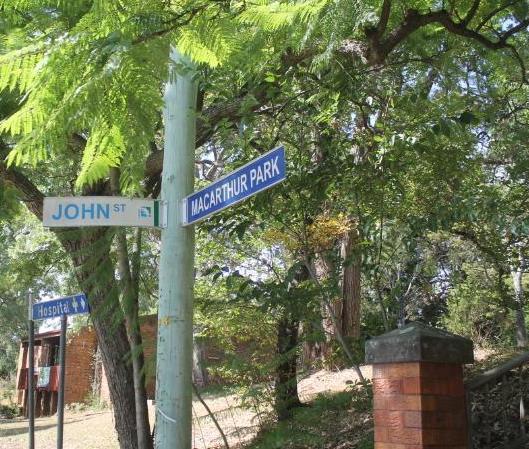 CAMDEN. Presbyterian Church.- The foundation stone of a Presbyterian Church, under the superintendence of the Synod of Australia, was laid in the township of Camden, (on a site given by the Messrs. Macarthur), on the 8th instant, by William Howe, Esq.. of Glenlee, in the presence of a respectable assemblage, composed, among others, of Mr. James Macarthur, M.C., Mr George Macleay, J.P.. Mr. William Howe, jnr J P Mr. Charles Tompson, &c. The Rev H R. Gilchrist having engaged in prayer. Mr. Howe proceeded to lay the foundation stone, and afterwards addressed the meeting in language highly impressive and appropriate...CAMDEN. (1850, July 11). The Sydney Morning Herald (NSW : 1842 - 1954), , p. 3. Retrieved fromhttp://nla.gov.au/nla.news-article12919378
CAMDEN. Presbyterian Church.- The foundation stone of a Presbyterian Church, under the superintendence of the Synod of Australia, was laid in the township of Camden, (on a site given by the Messrs. Macarthur), on the 8th instant, by William Howe, Esq.. of Glenlee, in the presence of a respectable assemblage, composed, among others, of Mr. James Macarthur, M.C., Mr George Macleay, J.P.. Mr. William Howe, jnr J P Mr. Charles Tompson, &c. The Rev H R. Gilchrist having engaged in prayer. Mr. Howe proceeded to lay the foundation stone, and afterwards addressed the meeting in language highly impressive and appropriate...CAMDEN. (1850, July 11). The Sydney Morning Herald (NSW : 1842 - 1954), , p. 3. Retrieved fromhttp://nla.gov.au/nla.news-article12919378
Before the age of wholesale vandals and thieves in all guises our churches were sanctums open during the day for all people – they were the sanctuaries they were intended to be from their outset, a place for a quiet prayer or a place to lift the eyes and marvel at ceilings, at stonework and windows that blaze with colour when the sun shines through them or have a quality of luminescence at all others times too. Visiting churches to learn of their history, therefore, gives you something more than an appreciation of architecture and how spaces are built to capture light and sound and expound them.
St. John's is a wonderful example of this outer manifestation for your inner senses and self to dwell in, even during a short meditation. St. John's old Musical and Dramatic Society, the wonderful organ, grounds, plants and even getting to giggle under a street sign that speaks of Macarthur Park and hearing two seconds of that old song prior to remembering this 'park' stems from something much older and much better are well worth the drive next time you want green open spaces and something worth visiting simply due to its establishing a credo that has endured.
Special thanks to congregation members Diana Davison and Dorothy Illingworth, who were able to provide such wonderful insights during an April 2016 visit to this lovely old church on its weekly Open Day.
We hope this small insight, and the material shared below, inspire you to seek out some of where we came from and visit during the upcoming July school holidays - or at any other time, for that matter.
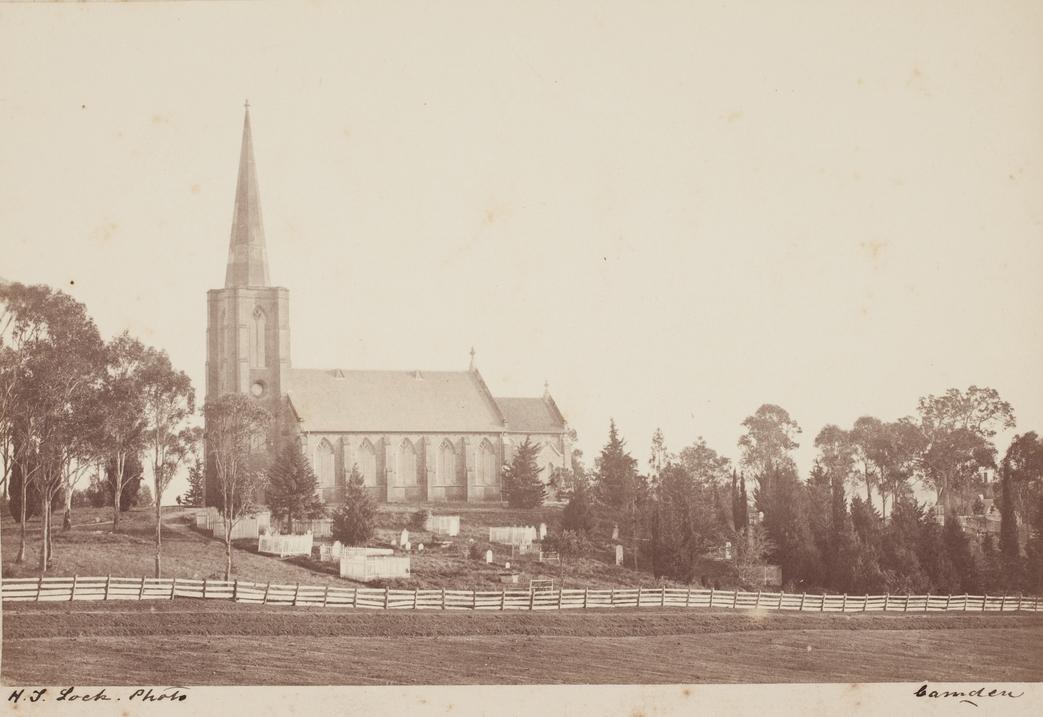
'Views of St John’s Church, Camden', from Album: Macarthur Family miscellaneous photographs and prints, ca.1862-1915 - Photo No.:: a2423005, courtesy The Mitchell Library, State Library of NSW.
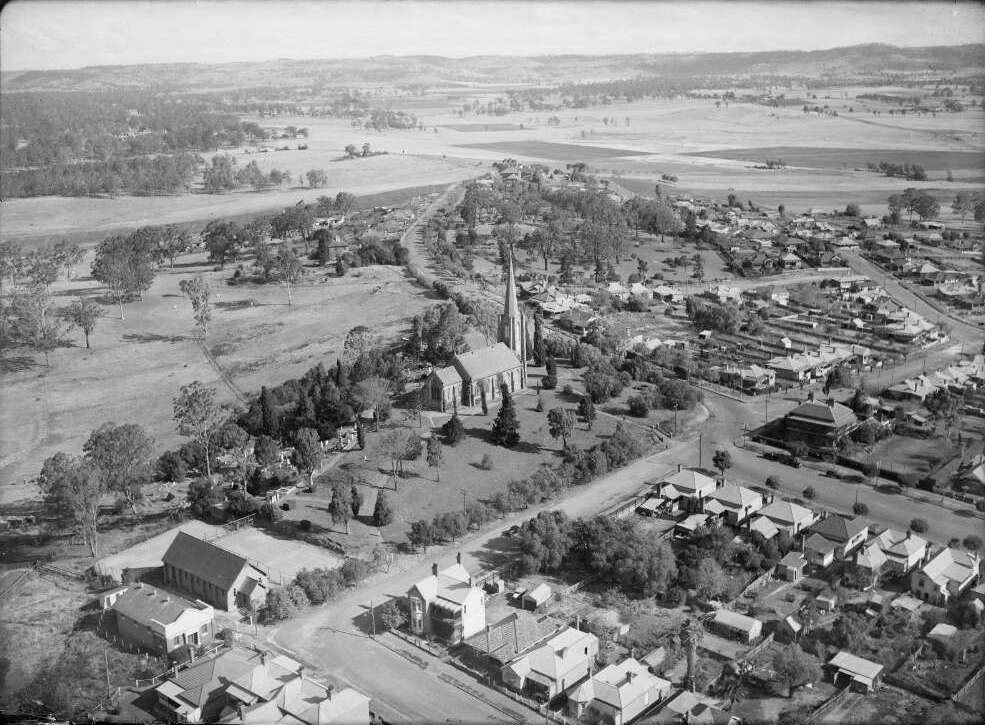
St Johns Camden, Edward Searle Photo from Air 1940 Photo No.: nla.obj-141898884-1, courtesy National Library of Australia.
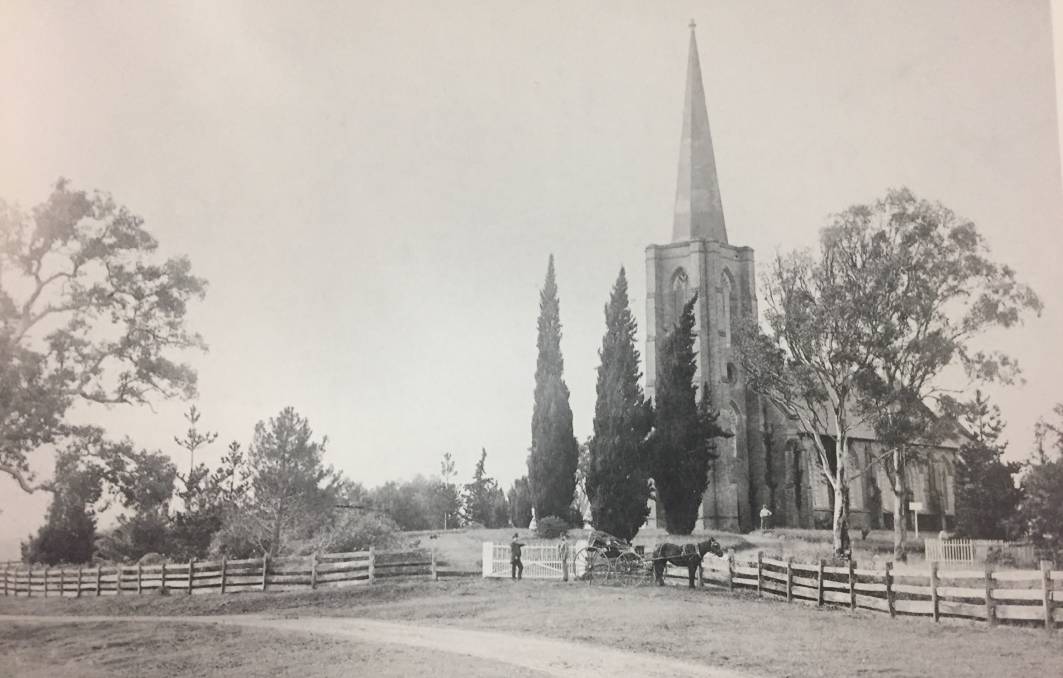
St John's Camden. photo by Charles Kerry, courtesy Camden Museum
Extras:
The M'Arthur - Macarthur Family - 1st and 2nd Generation
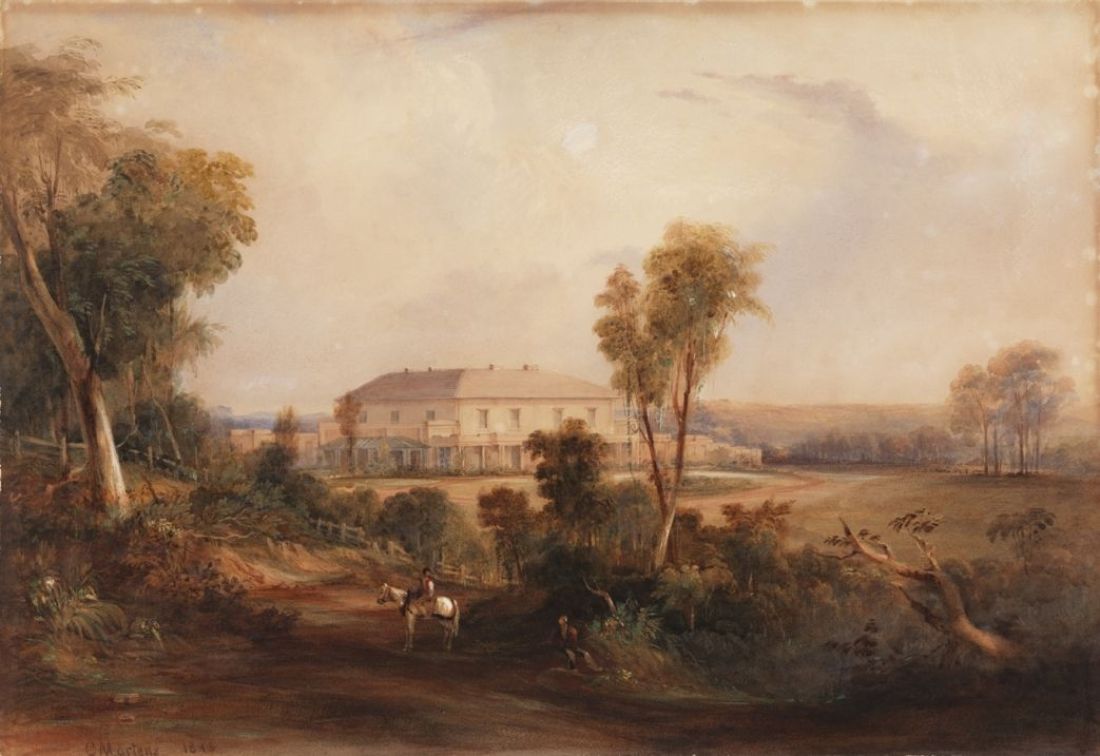
Camden Park House painted by Conrad Martens, 1843. Image No.: 954352 Typed label verso: "The painting of "Camden Park House" by Conrad Martens dated 1843 was commissioned soon after the building was finished and sent by Mrs James Macarthur (nee Emily Stone) to her relatives in England. About the year 1900, Mrs J.W. Macarthur-Onslow when on a visit to England was given the picture by Mr Archie Norman of Bromley, Kent. It was bought back to Australia and hung at Gilbulla, Menangle. In 1931 it was moved to Camden Park House. When Mrs J.W.Macarthur-Onslow finally left Camden Park in 1947 the picture went with her. On her death in 1952 it passed to her daughter Mrs Elizabeth Enid Rothe". Courtesy Mitchel Library, the State Library of NSW.
DIED. At Camden, on Friday last, JOHN M'ARTHUR, Esq. M. C. This Gentleman in political life, advocated the imperious principle of confining all offices and civic honours to Emigrants. In private society he united the highest qualities. His prisoner servants never had occasion to complain of deficient sustenance and it is much to be regretted that strong political prejudices should have so much sullied the otherwise excellent disposition of such a man. Family Notices (1834, April 15- Tuesday). The Sydney Gazette and New South Wales Advertiser (NSW : 1803 - 1842), , p. 3. Retrieved from http://nla.gov.au/nla.news-article2215894
Although Anglican, John M'Arthur wished everyone to have their own church:
John Macarthur, Esqr., has kindly offered sufficient land in the vicinity of the Nepean, for the erection of a Roman Catholic Chapel and Chapel House, and an adjoining plot for a burying ground. DOMESTIC INTELLIGENCE. (1832, February 27). The Sydney Herald (NSW : 1831 - 1842), , p. 3. Retrieved from http://nla.gov.au/nla.news-article12844162
MR. JOHN MACARTHUR.
The name of John Macarthur stands out with conspicuous boldness as one of the pioneers who laid the foundations of Aus-tralian nationality. By his impetuous and impulsive nature he not only made history for himself but also for the colony of New South Wales. His foresight and enter-prise turned the natural advantages, of the country, into the channel which in due time led to that marvellous volume of industrial prosperity with which his name will always be associated in our traditions. He was born at Plymouth, Devonshire, in 1767, and came of a Jacobite family. His father and uncles fought for Prince Charlie at Culloden. He entered the army, huton the close of the American War, when his regiment was disbanded, he purchased a commission in the New South Wales corps and, accompanied by his young wife, came out to the colony with Governor Phillip, in 1890. He obtained a grant of 200 acres of land at Parramatta. In January, 1793, during Governor Phillip's absence in England, he was appointed Resident at Parramatta by Lieutenant-Governor Grose, who found himself personally unable to manage the whole (of the affairs. of Government,- ' owing to the spread of the settlements/ Grose styled him 'Colinsellor.' In 1796, when the colony was suffering from a dearth tit provisions, two sloops, the ' Reliance ' and ' Supply,' were despatched, under command of Captains Kent and Waterhouse, to the Cape of Good Hope for relief supplies. It hap-pened that on their arrival there some merino sheep from the celebrated Escurial flock, which had been presented to the Dutch, by the King of Spain, were about to be sold. The Cape Dutch knew nothing of their worth, but Kent and Waterhouse did, and purchased twenty of them. Macarthur obtained five ewes and three rams as his share of them. Unlike the other colonists, who gave their attention only to the butchers' market, he carefully preserved his sheep, and increased their number, in order to improve the quality of his wool. This was the beginning of our great .wool industry, and obtained for Macarthur the distinction of 'Father of the colony.' His impulsive disposition, however, got him into many troubles, Some time about 1800 he was involved in a quarrel between Governor King and the officers of the New South Wales Corps over the traffic in spirits. He fought a duel with Colonel Paterson, who sided with King, in which he dangerously wounded his opponent. He was put under arrest and ordered to Norfolk Island for service, but was afterwards required to enter into recognisances to keep the peace. This he declined to do ; he demanded a court-martial, and refused to quit arrest. King accordingly sent him to England, but'he was ordered back by the Horse Guards, who considered the Governor had erred in judgment, and released Macarthur from arrest. He then retired from military service, and devoted himself to his favourite pursuit of sheep-farming and the export of wool to England. He gave great attention to growing pure and crossbred wools. Whilst in England he was examined by a committee of the Privy Council, at the. instance of wool manufacturers, on the subject of wool-growing in Australia, and Lord Camden ordered that a grant of 2000 acres be made to him.
This land he selected at the Cowpastures, . Camden. He brought with him on his return to the colony two merino ewes and three rams from the flock of George III.
In 1806 he got at loggerheads with Governor Bligh over a number of matters, in which it was thought the Governor acted highhandedly. The most serious rupture was his arrest and committal for 'high misdemeanours,' or alleged breach of post regulations in concealing an escaped prisoner on his schooner, the ' Parramatta.' This was a cause célebre that created immense excitement, as well as disorder, amongst judge, advocate, officials, and military. The upshot of the matter was the deposition of Bligh himself by Colonel Johnston, under strong pressure fromtIhe civic and military elements, to 'prevent insurrection.' Macarthur was subsequently tried before the Criminal court, to clear him from the imputations, and was unanimously acquitted.
He died on April 10, 1884. A memorial window of him has been placed in Camden Church, and his son, General Sir Edward Macarthur, placed a window in St. Andrew's Cathedral, Sydney, in honour of both his parents. His son, Mr. James Macarthur, who died in 1867, left a daughter, who is married to Captain Onslow. MR. JOHN MACARTHUR. (1891, December 19). Illustrated Sydney News (NSW : 1881 - 1894), , p. 22. Retrieved fromhttp://nla.gov.au/nla.news-article63613524
Macarthur brothers purchasing land at same time getting ready to create the the Village of Camden - Taralga is a small village in the Southern Tablelands of New South Wales, Australia in Upper Lachlan Shire. It is located at the intersection of the Goulburn-Oberon Road and the Laggan-Taralga Road. It is accessible from Oberon to the north, Mittagong to the east, Goulburn to the south, and Crookwell to the west. At the 2011 census, Taralga had a population of 285 people. The exact origin of the name Taralga is disputed. The two most widely supported theories are that the village was originally known as "Trial Gang" as within the early colonial boundaries of Argyle County, it was a location for the trials of convicts and bushrangers before the Crown. The second theory is that Taralga means "native companion" in the language of the Burra Aboriginal people [from Wikipedia]
2-LIST of eighteen Allotments of Land in Sydney, for which Title Deeds will be issued, unless written Caveats are entered. 3-LIST of Crown Lands, which will be sold by auction on Wednesday, November 11th. Brisbane Water - fifty acres, by Elizabeth Murray; Narabeen (Cumberland) - fifty acres, by Robert Pearce; Taralga Creek-eight hundred acres, by J. and W. Macarthur; same place-one thousand acres, by same; same place-eleven hundred acres, by same; CONTENTS OF WEDNESDAY'S (1835, September 26). The Sydney Monitor (NSW : 1828 - 1838), , p. 3 (MORNING). Retrieved from http://nla.gov.au/nla.news-article32149796
Both James and William Macarthur, educated in England, were advocates of the establishment of the University of Sydney during 1849 Debates, the year St John's was finally consecrated, and part of the 1850 realisation of providing a higher class of education for people in Australia through the' An Act to incorporate and endow the University of Sydney'. ( See: Legislative Council. (1849, October 10). The Maitland Mercury and Hunter River General Advertiser (NSW : 1843 - 1893), , p. 4. Retrieved from http://nla.gov.au/nla.news-article699622, Legislative Council. (1849, October 17). The Maitland Mercury and Hunter River General Advertiser (NSW : 1843 - 1893), , p. 4. Retrieved from http://nla.gov.au/nla.news-article699404, Passed September 24, 1859: UNIVERSITY OF SYDNEY. (1850, September 25). The Sydney Morning Herald (NSW : 1842 - 1954), , p. 2. Retrieved from http://nla.gov.au/nla.news-article12921328 SEE: An Act to incorporate and endow the University of Sydney.)
JAMES MACARTHUR ESQ.
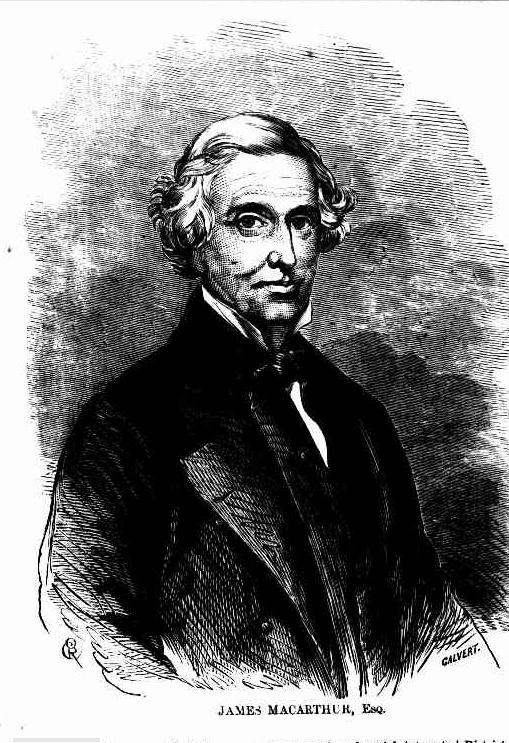 THE gentleman, whose portrait we now give, is the third son of the late John Macarthur, Esq., of Camden, the founder of the Australian wool trade. Mr. J. Macarthur was I born at Parramatta, in 1798, and received the rudiments of his education from the family tutor. In the year 1809, with his younger brother (now Sir William Macarthur), he sailed with his father to England, and was placed at Grove Hall Academy, conducted by Dr. Lindsay, where he completed his studies, and, in 1815 he accompanied his father and brother to the Continent.
THE gentleman, whose portrait we now give, is the third son of the late John Macarthur, Esq., of Camden, the founder of the Australian wool trade. Mr. J. Macarthur was I born at Parramatta, in 1798, and received the rudiments of his education from the family tutor. In the year 1809, with his younger brother (now Sir William Macarthur), he sailed with his father to England, and was placed at Grove Hall Academy, conducted by Dr. Lindsay, where he completed his studies, and, in 1815 he accompanied his father and brother to the Continent.
As Mr. Macarthur, sen., wished to acquire an intimate knowledge of the cultivation of the vine, they remained until the end of the summer at the Chate lard, near Clarens; the autumn and winter months were passed at Vevay in inspecting the vintage ope rations. In the following year they visited the Rhone, whence they proceeded to Cette and Marseilles, examining the olive and mulberry grounds, and adding to their collection of grape vines and other valuable plants. After staying about twelve months in London, in 1817, Mr. Macarthur secured a passage for him self and family on board the Government transport Lord Eldon, with space of plants. Mr. J. Macarthur was then employed for several years in the management of his father's affairs, and in performing the duties of an unpaid magistrate; With his brother and the late Mr. Harington he formed the first Court of Petty Sessions ever held in the Cowpasture (or Camden) district. This was also the first instance of magisterial duties being performed without remuneration in this colony. In-1824 he became senior member of the colonial committee of shareholders of the Australian Agricultural Company, and it became necessary that he should communicate personally with the directors in England where, on his arrival, he was instrumental in obtaining the appointment of Sir Edward Parry, who became commissioner to the Company. While in London Mr. Macarthur was called as a witness in reference to colonial expenditure by a committee of the House of Commons. He also visited Germany, and examined the most celebrated flocks of Saxony. On his return he spent several days at Paris towards the close of the Revolution in 1830. He arrived again in this country the same year, and took an active part at meetings in reference to the disposal and administration of Crown lands, acting with Mr. Wentworth, Dr. Wardell, and other leading colonists, until the appointment of Sir Richard Bourke to the government of this colony put an end to the agitation.
In 1836 Mr. Macarthur again went to England, taking charge of petitions to the King and Parliament embracing the whole question of transportation as well as immigration, and relating also to the steps which were deemed advisable before establishing a representative Assembly in this colony. These petitions set forth, that the prosperity of the colony was counterbalanced by lamentable depravity of manners, and a fearful prevalence of crime, arising from relaxed discipline, inadequate instruction, and above all, a constant influx of criminals ; that the number of virtuous free immigrants was not sufficiently large to check the contaminating influence of the convict element, and infuse a better tone into society ; that part of the land revenue was devoted to other purposes than immigration; that the judges were liable to be dismissed at pleasure, and praying that full inquiry into the condition, of the colony should be made by the Imperial authorities. The petitions were supported by a work published by Mr. Macarthur, entitled, "New South Wales, its present state and future prospects." Mr. Macarthur was examined at great length by Sir W. Molesworth's committee on transportation. He also endeavoured, in conjunction with the late Mr. Charles Buller, and assisted by Mr. Francis Barlow, secretary to Lord Lyndhurst, to frame a constitution based upon the principle of double election now prevailing in Norway, and which it was thought by many distinguished statesmen would suit the colonies, but the attempt was relinquished, and Mr. Macarthur recommended, as an interim measure, the opening the doors of the Council Chamber to the public, and to increase the number of members so as to secure practical representation.
In 1838, Mr. Macarthur married Emily, second daughter of the late Henry Stone, Esq., of Lombard-street, and returned to the colony in the following year, when he became a member of the Legislative Council. In this capacity he took a prominent part in the debates, and warmly supported the policy of free immigration, maintaining that the time had come when New South Wales ought no longer to be a convict colony, but a place for the settlement of a free and virtuous population, who would introduce the blessings of civilisation was that a vast desert into a fruitful land. Having relinquished his seat in the Legislature, he received a present of a silver breakfast service and salver subscribed for chiefly by the inhabitants of Sydney and Parramatta in recognition of his conduct as a member of the Council. At this time a change took place in the Constitution, one-third of the Council being elected by the people, and Mr. Macarthur was invited by the electors of Cumberland to stand. He consented, and his return appeared certain, but in the mean time he had supported the election of Mr. (afterwards Judge) Therry, who was distasteful to a large party through whose influence Mr. Macarthur was rejected, and his opponent (Mr. I Charles Cowper) ' returned by a large majority. Mr. Macarthur was then offered a seat as a nominee of the Crown, which, however, he refused, considering that he could not serve the country effectively in that capacity after having been rejected by a popular constituency. He entered the Council Chamber again in 1848, when he was returned by the electors of Camden (including Illawarra) without opposition. He was elected a second time in 1851, and continued to serve till 1856, when the new Constitution came into force. Mr. Macarthur was then chosen for West Camden. He was appointed a member of the interim Executive Council, but received no emoluments of office, nor did his seat become vacant by reason of its acceptance, but from constitutional scruples he resigned, and again appeared before his constituents, and was re-elected without opposition. Mr. Macarthur continued to discharge the duties of a representative of the people until the dissolution which preceded the new Assembly under the Electoral Act of 1858. When the elections took place in 1859, although invited to come forward, he declined, on the grounds of failing health, to again contest his former constituency.
The story of Mr. Macarthurs family begins with Australian colonization, and none have contributed more to the material and social interests of the people. Camden, the family seat, celebrated throughout the world in its connection with the first growth of Australian wool, was also the scene of earliest colonial experiments in the culture of the vine. In public life Mr. Macarthur has worthily tilled the offices of magistrate and legislator. His enlightened advocacy of the principles of modem commercial legislation is well known and remembered.
On the occasion of Mr. Macarthur's last departure for Europe, a deputation consisting of the Hon,,T. A. Murray, Esq., then Speaker of the Legislative Assembly (now President of the Legislative Council), Sir Charles Nicholson, Sir W. M. J Manning, J. H. Plunkett, Esq., M.LA., . If and other influential gentlemen, presented f f the following address :-
"TO JAMES MACARTHUR, ESQ.
""We, the undersigned colonists of New South Wales, desire to convey to you on tho occasion of your departure from tho Colony, tho expression of our sincere regard and esteem, and of our earnest hopes for the health and happiness of yourself and family during your contemplated voyage to and sojourn in Europe.
"We deem the present a suitable occasion for giving expression to these feelings, and desire to record some sense of the obligations which these colonies owe to the family of which you are a member, and to the example of individual worth and active benevolence evinced by you as a member of the Legislature, a magistrate, a landlord, and a promoter of every object calculated to develop the moral and material advancement of the community."
The following appeared in the Sydney Morning Herald on the 17th April, 1860:-
" Among the notices of departures by the mail of to-day, we see the mention of Mr. James Macarthur, of Camden, whoso name is familiar to every colonist. As the landlord of a numerous tenantry, over whose welfare he has watched with a solicitude which has won their confidence and affection as the most prominent of the magistrates of this country, and the centre of every movement to improve its material and intellectual resources-his absence, if only for a year or two, must be a matter of regret. Such men, and such families, we can all spare just now-when much that was once respected and respectable is receding before a new social and political epoch. Mr. Macarthur was for many years among the most prominent of our public men-a sober and consistent advocate of popular government and true liberty-strenuous resisting every thing mean and demoralising, under whatever auspices it might appear.
"When Responsible Government was inaugurated, Mr. Macarthur accepted a seat in the Executive, and it would have been fortunate for the colony had his health and engagements suffered a more full devotion of his time and talents to the public weal.. '' We believe no man in the House was more thoroughly trusted-none whoso personal character attracted greater esteem.
"We hope that his visit to England will be subservient to his health and social happiness, and that we shall soon see him again take an active part in the Legislature of this his native country."
In England Mr. Macarthur was one of the representatives of New South Wales at the International Statistical Congress held at London in 1S60, and opened by the late Prince Consort. He was also one of the Commissioners at the International Exhibition of 1862. We rejoice to learn1 IK that Mr. Macarthur's visit to Europe has been of very great advantage in re-establishing his health, and that he has now returned to the the Colony with his family. A quarter of a century ago, when the District Police Bill was under discussion in the Legislative Council, he is reported in the Colonist to have said that from the first moment he was capable of having his attention drawn it to such subjects-he had been taught to look to the good of this Colony as the great object of his life, and certainly its best interests have ever engaged his deepest sympathies.
The satisfaction of Mr. Macarthur's neighbours and friends on his return was indicated by a public banquet attended by I more than 500 persons, and where men of every shade of politics in the neighbourhood united to welcome a colonist who had deserved so well of his country.
JAMES MACARTHUR, ESQ.
The likeness of Mr. Macarthur is taken from a photograph, of a portrait by the Cavalier Capalli, of Rome, in the Hall of the Sydney University. JAMES MACARTHUR, ESQ. (1865, March 16). Illustrated Sydney News (NSW : 1853 - 1872), , p. 4. Retrieved from http://nla.gov.au/nla.news-article63512321
MR. JAMES MACARTHUR.
The Sydney daily papers of Wednesday contain biographical sketches of the late Mr. James Macarthur, of Camden Park, whose sudden death has just been announced. The Herald says:
" A notice has just reached us of the decease of Mr. James Macarthur, of Camden Park-a name that awakens many colonial memories, and which will remain in the history of this country as long as it shall be inhabited by civilised men. The large circle in which Mr. Macarthur once moved as an active and prominent member of society has been much reduced by removals and death. Yet no demise could have created a more general feeling of respectful regret. Mr. Macarthur was present at Divine service on Sunday. He retired for the night, without discovering any symptoms of pain, and unusually cheerful. Soon after attention was drawn to him by a tremour followed by stillness. A light was brought. The time of his departure had, however, come, and without recognition of those around him, or symptoms of agony, he breathed his last. A disease of the heart which had been many years in the course of development was, we understand, the cause of his death-one which terminates suddenly so many valuable lives. The loss of such a man must always be considerable. The influence of his reputation and character was alone a public blessing. No one enjoyed more completely the confidence of his friends. He has left a widow, and one daughter, recently united to Captain Onslow, of the Royal Navy, and brothers who tread closely upon that period which marked the years of his pilgrimage."
The Empire says :
" Mr. James Macarthur, the Treasury Minister in the first Responsible Government of New South Wales (that of Mr. Donaldson), was born at Parramatta in December, 1798. He was the third son of the late John Macarthur Esq., who arrived in the colony towards the close of last century, as captain and paymaster of the New South Wales Corps or 102nd Regiment. This gentleman sold out or relinquished the service at a comparatively early period after his arrival in the colony, and established himself as a mer-chant and shipowner in Sydney. He is known in the history of the colony as the introducer of merino sheep, and the consequent founder of that great staple product for which Australia is now famous in the commercial world. The sheep were imported by Mr. John Macarthur, in conjunction with the late Rev. Samuel Marsden and Captain Kent; but the other two gentlemen soon abandoned the enterprise. Mr. James Macarthur's education was commenced in New South Wales, under a French emigrant gentleman, named Louis de Harillean ; but at an early age he accompanied his father to Eng-land, and was at school some years in the neighbourhood of London. Mr. Macarthur, senior, who was implicated in the Bligh Rebellion in 1808, was ordered home to wait the issue of the trial of Colonel Johnston, the principal actor in that affair ; and he was afterwards prohibited by the Secretary of State from returning to the colony for eight years. During part of this period, Mr. James Macarthur, in company with one of his brothers, continued his studies under Dr. Lindsay, of Stratford-le-Bow, a clergyman of the Church of England, who, in consequence of having embraced Unitarian doctrines, had renounced his living ; and we believe Mr. Macarthur's education was completed in France, but without his going to any college or university." [According to the Herald, Dr. Lindsay was an orthodox dissenting divine.]
"Mr. Macarthur travelled some time in France and Switzerland, with a special view of obtaining a knowledge of the culture of the grape and the manufacture of wine. He returned to the colony with his father in the year 1817, and for a considerable time from this date he appears to have been principally occupied in improving the beautiful estate of Camden, occasionally taking part as a country gentleman in public affairs. About the year 1827, he again visited Europe, on which occasion, we may mention as an indication of the political views he had adopted, that he carried to London the petition got up at the time in opposition to the labours of the Patriotic Association for free institutions. While in England, he published a work, in one volume, entitled ' New South Wales, its Present State and Future Prospects,' which, however, is seldom referred to by readers of Australian history. He returned to the colony from this visit in March, 1839.
" On the 13th of May, 1840, Mr. Macarthur was appointed by the late Sir George Gipps a member of the old Nominee Council, and he continued to sit in that capacity till the inauguration of a partly elective Legislature in 1843. He took an active part in the deliberations of that body, which were chiefly swayed by the superior talent of the Governor, who presided over the meetings, and the tenor of his conduct was decidedly liberal for the character of the Council. At the first general election Mr. Macarthur offered himself as a candidate for the county of Cumberland, and was defeated, in consequence of the prominent part he had taken in promoting the election of Mr. Roger Therry for Camden, where his family influence was sufficiently powerful to decide the representation of the county. The successful candidates for Cumberland, which at that time returned two members; were Mr. Charles Cowper, and the late Mr. William Lawson. In constituting the nominee part of the Council, Governor Gipps offered one of the seats to Mr. Macarthur, who at once declined it, stating that, as he had been refused admission to the Legislature by a popular constituency, he would not consent to enter the same house by the back door of a Government appointment. Mr. Therry resigned his seat, upon being promoted to a judgeship at Port Phillip, but Mr. Macarthur did not come forward for the vacancy, which undoubtedly he could have filled; nor did he attempt to enter that Council during the five years of its existance. At the general election in 1848, he was returned for Camden ; and at the next general election, in 1851, he was elected after a contest for the Western division of that county, the constituency having been divided by the Electoral Act of 1850. In 1856 he was returned as one of the members for West Camden to the Legislative Assembly.
" As a representative member of the Legislature, Mr. Macarthur manifested a strong liking for that spurious commodity known as colonial conservatism. He was prominent on the Government side in the debates of 1842, when Mr. Wentworth endeavoured to put the screw upon the Colonial Office by threatening to stop the supplies. He was one of the chief advisers of Mr. Wentworth, in the following year, in framing the Constitution Bill, and, as a member of the committee appointed to perform that duty, and in the House, he steadily sup-ported all the restrictive and unpopular pro-visions of that measure as it was passed. We have reason to believe, however, that Mr. Macarthur never favoured the hereditary clauses, which he looked upon from the first as belonging to a by-gone state of civilization. In commercial legislation, he was an avowed disciple of free trade, and he was an avowed advocate of the National system of education.
" In the year 1838, Mr. Macarthur married Emily, daughter of Mr. Stone, a London banker, by whom he had one child, a daughter.
" The private character of Mr. Macarthur was honourably distinguished for his practical benevolence. To his numerous tenantry he was a considerate and respected landlord ; and he was one of the best employers among our country proprietors.
" In his late years Mr. Macarthur fully sustained the estimate formed of his public and private worth at the period referred to. In the year 1866 he was appointed by the present Government to a seat in the Legislative Council."
We may add from the Herald :
" Thus, one by one, the men who have founded this colony and established its fortunes are passing away: The interest of Mr. Macarthur in the country was intense, and ardent. As a landlord he was most considerate and forbearing, and immense losses were borne by him with cheerfulness where they were inevitable, and without resentment even where they were unjust. In religion Mr. Macarthur was a man of large views. He looked through forms to the great principles which constitute the value as well as the authority of the Christian religion. Though warm in condemning as a legislator that which he believed to be evil, he was distinguished for the calmness and genuineness of tempor, and the dignity and modesty of his self-appreciation. No man was less prone to give offence, or to take it, unless under the conditions in which acquiescence would be meanness.
"The surviving brothers of Mr. Macarthur are Sir Edward, the elder, and Sir William Macarthur, who was born in 1800. The first of these gentlemen passed through a long course of service, towards the close of which he administered the Government of Victoria. Sir William was Commissioner for this colony at the first universal Exhibition at Paris, where he received the decoration of the Legion of Honour. The sister of these gentlemen was married to Mr. (afterwards Sir) Watson Parker, for some time Chairman of Committees, and subsequently Premier shortly after the establishment of responsible government in this colony." MR. JAMES MACARTHUR. (1867, April 27). The Maitland Mercury and Hunter River General Advertiser (NSW : 1843 - 1893), , p. 3. Retrieved from http://nla.gov.au/nla.news-article18733192
OBITUARY. SIR WILLIAM MACARTHUR.
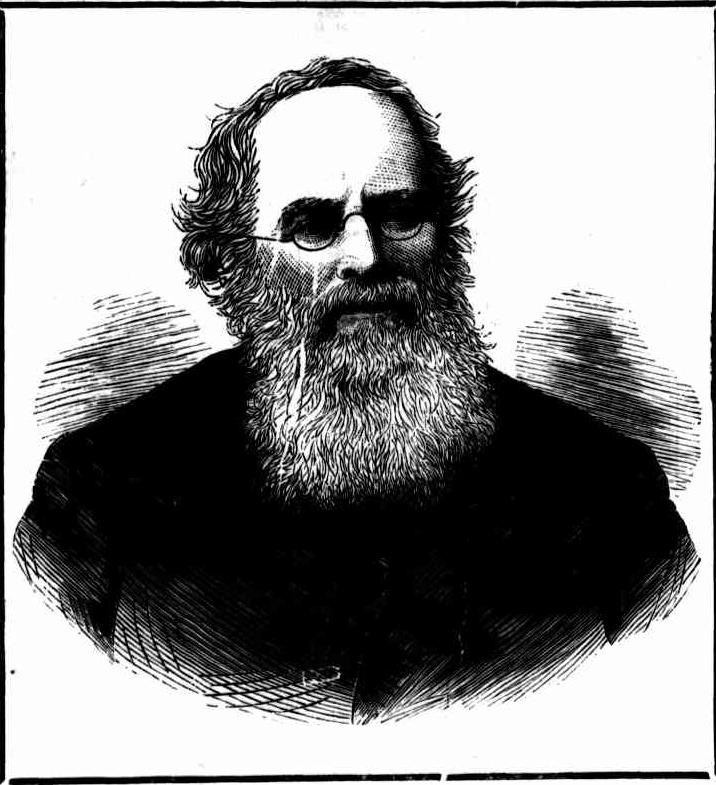 Another of the few remaining links which connected the present day with the very early period of the history of New South Wales has been snapped asunder by the death of Sir William Macarthur, at his residence, Camden Park, on Sunday. Sir William was one of the oldest natives of the colony, having been born at Parramatta—then called Rose Hill—so far back as December, 1800, and consequently he was at the time of' his death very nearly 82 years of age. His father, Mr. John Macarthur, arrived here as a subaltern in the celebrated 102nd, or N. S. W. regiment, and the part he took in the revolution or rebellion, in the time of Governor Bligh is too well known to need recapitulation. But it was in another direction that Mr. John Macarthur's efforts for the benefit of the colony were of more importance. He was the first to perceive the value of our natural pasture for the growth of fine-woolled sheep, and his timely introduction of the merino breed and his successful treatment of his flocks certainly went a long way towards precipitating the infant colony into a great nation. Mr. John Macarthur had a large family of sons, William being the fourth, most of whom have risen to considerable eminence in their several walks of life. In the year 1809 he took the boys home to England, in order that they might receive that liberal education that was at the period almost unattainable in the colony. In 1817 he brought his boys back to their native land, and William, then but a youth, at once devoted himself to those pastoral and agricultural pursuits which absorbed a large portion of his future life. In the year 1849 he was elected a member of the old nominee and elective Legislative Council, a position which he occupied until the advent of responsible government in the year 1856. However, Mr. William Macarthur had never troubled himself very much about politics, but concerned himself much more about his flocks and herds and his crops than he did about political matters. Consequently his seat in the Council was often vacant, and at the time of the Great Exhibition of Paris in 1854 Mr. Macarthur was the representative commissioner for the colony of New South Wales. In this capacity, he acquitted, himself so well that he received the distinction of knighthood from his own Sovereign and the Cross of the Legion of Honour from the Emperor of the French. He returned to the colony in 1857, and, Cincinnatus like, resumed his favourite pursuits at Camden Park. He took a very active part in the arrangements that were made to secure the proper representation of the colony at the second Great Exhibition in London in 1862, and though he went there and gave much valuable assistance he declined to accept the onerous post of official representative of the colony. After a tour through Europe, Sir William returned to the colony in 1864, soon after which he was appointed a member of the Legislative Council. He took a very great interest in the affairs of the Agricultural Society of New South Wales, and he wrote some treatises on the cultivation of the vine and the manufacture of wine. Of late years Sir William's attendance in Parliament has been somewhat seldom. During the session of 1878-9—an unusually long one, extending from the 10th September, 1878, to the 21th July, 1879—he attended only 16 times, the last occasion on which he was present being the 14th May. In consequence of his infirmities leave of absence was given to him for the remainder of the session, but as no application for leave was made subsequently his name remained upon the Council roll, although he was unable to attend. On the meeting of the present Parliament, on the 22nd August last, the President reported that Sir William Macarthur, having for two successive sessions of the Legislature failed to give his attendance in the Legislative Council without the permission of her Majesty, or of the Governor, signified by the Governor to the Legislative Council, and having thereby, under the 5th section of the Constitution Act, vacated his seat, he (the President) had in consequence directed that Sir William Macarthur's name be struck from the alphabetical list of members, He much regretted having to make this announcement, as he was sure it was painful for every member of the Council to be thus disassociated from one who had rendered, and whoso family had rendered, such good service to the colony. For some time past 8ir William Macarthur was very feeble, and his end was by no means unexpected. Ho died of old age, full of years and full of honours, and his memory as a citizen of the colony will long be held in affectionate esteem. OBITUARY. (1882, October 31). The Sydney Morning Herald (NSW : 1842 - 1954), , p. 5. Retrieved from http://nla.gov.au/nla.news-article13527374
Another of the few remaining links which connected the present day with the very early period of the history of New South Wales has been snapped asunder by the death of Sir William Macarthur, at his residence, Camden Park, on Sunday. Sir William was one of the oldest natives of the colony, having been born at Parramatta—then called Rose Hill—so far back as December, 1800, and consequently he was at the time of' his death very nearly 82 years of age. His father, Mr. John Macarthur, arrived here as a subaltern in the celebrated 102nd, or N. S. W. regiment, and the part he took in the revolution or rebellion, in the time of Governor Bligh is too well known to need recapitulation. But it was in another direction that Mr. John Macarthur's efforts for the benefit of the colony were of more importance. He was the first to perceive the value of our natural pasture for the growth of fine-woolled sheep, and his timely introduction of the merino breed and his successful treatment of his flocks certainly went a long way towards precipitating the infant colony into a great nation. Mr. John Macarthur had a large family of sons, William being the fourth, most of whom have risen to considerable eminence in their several walks of life. In the year 1809 he took the boys home to England, in order that they might receive that liberal education that was at the period almost unattainable in the colony. In 1817 he brought his boys back to their native land, and William, then but a youth, at once devoted himself to those pastoral and agricultural pursuits which absorbed a large portion of his future life. In the year 1849 he was elected a member of the old nominee and elective Legislative Council, a position which he occupied until the advent of responsible government in the year 1856. However, Mr. William Macarthur had never troubled himself very much about politics, but concerned himself much more about his flocks and herds and his crops than he did about political matters. Consequently his seat in the Council was often vacant, and at the time of the Great Exhibition of Paris in 1854 Mr. Macarthur was the representative commissioner for the colony of New South Wales. In this capacity, he acquitted, himself so well that he received the distinction of knighthood from his own Sovereign and the Cross of the Legion of Honour from the Emperor of the French. He returned to the colony in 1857, and, Cincinnatus like, resumed his favourite pursuits at Camden Park. He took a very active part in the arrangements that were made to secure the proper representation of the colony at the second Great Exhibition in London in 1862, and though he went there and gave much valuable assistance he declined to accept the onerous post of official representative of the colony. After a tour through Europe, Sir William returned to the colony in 1864, soon after which he was appointed a member of the Legislative Council. He took a very great interest in the affairs of the Agricultural Society of New South Wales, and he wrote some treatises on the cultivation of the vine and the manufacture of wine. Of late years Sir William's attendance in Parliament has been somewhat seldom. During the session of 1878-9—an unusually long one, extending from the 10th September, 1878, to the 21th July, 1879—he attended only 16 times, the last occasion on which he was present being the 14th May. In consequence of his infirmities leave of absence was given to him for the remainder of the session, but as no application for leave was made subsequently his name remained upon the Council roll, although he was unable to attend. On the meeting of the present Parliament, on the 22nd August last, the President reported that Sir William Macarthur, having for two successive sessions of the Legislature failed to give his attendance in the Legislative Council without the permission of her Majesty, or of the Governor, signified by the Governor to the Legislative Council, and having thereby, under the 5th section of the Constitution Act, vacated his seat, he (the President) had in consequence directed that Sir William Macarthur's name be struck from the alphabetical list of members, He much regretted having to make this announcement, as he was sure it was painful for every member of the Council to be thus disassociated from one who had rendered, and whoso family had rendered, such good service to the colony. For some time past 8ir William Macarthur was very feeble, and his end was by no means unexpected. Ho died of old age, full of years and full of honours, and his memory as a citizen of the colony will long be held in affectionate esteem. OBITUARY. (1882, October 31). The Sydney Morning Herald (NSW : 1842 - 1954), , p. 5. Retrieved from http://nla.gov.au/nla.news-article13527374
Sketch from: Sir,William Macarthur. (1882, November 4).Australian Town and Country Journal (Sydney, NSW : 1870 - 1907), , p. 17. Retrieved fromhttp://nla.gov.au/nla.news-article70992657
MR. WILLIAM MACARTHUR. The following letter from our representative --Mr Macarthur-to Captain Fyans, will be perused-with interest by his constituents in Port Phillip:- Camden, 4th May, 1849.
My dear Fyans,-It has been intimated to me, that some of my .friends at Port Phillip are desirous that I should make known to the electors, generally, my opinions upon some of the subjects which appear to excite the greatest public interest in the Southern Districts. I comply with their wishes the more readily, because I ams sure you will permit me to state them in the form of a letter to you, which perhaps you will be good enough to make public in any manner which may seem most advisable. I confess, that I should hesitate to send a statement of them direct from hence, to any of the Port Phillip newspapers, least by such a step I might seem to be endeavoring to bring myself, or my opinions, under public notice without sufficient cause. The question of separation I apprehend to be, the one which is paramount in the estimation of the inhabitants of Port Phillip. If it be so earnestly desired, as it would appear to be, from the testimony we receive upon the subject, I can conceive no possible objection to it on the part of the inhabitants of the Middle District. For whatever loss of influence with Government in England, may result to the colony as a whole, in consequence of Separation, this evil ought not to weigh with us, if the people of the Southern District desire so earnestly to be erected into a separate colony. I apprehend, however, that the measure rests entirely with the Home Government, and will not in any manner be made a subject of reference to the Legislative Council here. Until the Separation does tale place, common justice reqires that the public expenditure should be fairly apportioned according to the amount of Revenue derived from each of the two Districts respectively; and this is a principle which I shall endeavour to support to the best of my ability. I am averse to the resumption of Transportation to these colonies, in any shape. But while I state this expressly, I think it right also to make known, for the information of those persons who may have had no personal experience of a convict colony, some circum n stances which make rather for its renewal.
During a residence here of more than twenty years, before transportation and the assignment system were discontinued, I had abundant opportunity to estimate, to their full extent, the advantages and disadvantages of the “Convict System." During that period, I witnessed more instances of long-continued, faithful, and zealous service, on the part of the unfortunate class, whom it has of late become a sort of fashion to cry down, than I can ever expect to meet with from the free laborers of the present day; services not extorted by fear, for I could mention numerous instances of the strongest attachment of freed convicts to the service of their former assignees, and not a few who, faithful to the last, grew grey and died in their employment. That the system proved an evil one to this colony, is to be attributed rather to the existence of so many bad masters, and to negligence or corruption on the part of officials, than to any such universal tendency to misconduct, as it seems. now to be the object of many persons to inculcate. It is known here to be a well authenticated fact, that in a country district, in which the magistrates were ordinarily attentive to their duties, the class of Ticket-of-Leave holders was invariably the most orderly and best conducted class in it. There are evils connected with transportation, however, which would render rue averse to its renewal under any improvement in the system. I allude particularly to its tendency to increase the disparity between the sexes, and to the ill effects produced in a community by the existence of a degraded class. These evils, for some years past, have been gradually diminishing, and I should greatly regret to see any measure adopted which is calculated to ensure their increase. The subject of Education is another upon which my sentiments may be required. I am an advocate for a general system; I mean one under which all denominations of Christians may be educated together, in charity towards each other, I cannot comprehend why it is not practicable to teach to the whole the great truths of Christianity, without in any shape, interfering with the peculiar tenets of a portion. Their different articles of belief might surely be inculcated by their respective friends at home, or by their clergy at times to be set apart for the purpose. But although it is my opinion that the children of the working classes, under such a system, might be better taught at less expense -might be brought up with feelings of greater charity towards their neighbour, I am far from desiring that any general system of education, however good en itself, should be adopted in opposition to the declared wishes of the majority. I would support the denominational system, wherever the extent of the population should render it practicable, and the wishes of the inhabitants be expressed in its favor. I am persuaded, that unless confirmed in their prejudices by injudicious opposition, the supporters of the denominational system must sooner or later give way in favor of the advantages to be derived from a well digested system of general education. The subject of the administration of the Crown Lands appears to me to be the most momentous one which is at present agitated, and it is one upon which I have naturally had some cause to reflect. I will proceed to state briefly my opinions upon it. The existing system I would abolish as soon as might be consistent with any acquired rights on the part of the Squatters. I would cause the whole of the Crown Lands (township reserves excepted), to be placed under the two denominations, the agricultural and the pastoral, unless indeed hereafter it might be found expedient to club a third portion under the name of mineral lands, I won, at the earliest possible period, cause selections to be made, throughout the country occupied by the Squatters, of such lands as by their utility, combined with their probable local advantages, should seem to be the most eligible for the purposes of agriculture. These I would term agricultural lands, and would cause to be carefully surveyed and divided into sections of 40 to 160 acres, with occasional smaller sub-divisions, especially near the larger townships, that all classes of purchasers might be suited. I would then have them gradually brought into the market, and offered for sale by auction, in continuous lots, at a high minimum price-say, for instance, 20s, per acre-the quantity offered to be regulated at the discretion of government, by the apparent demand. Lots once offered or sale to be open to be purchased at the minimum price, on a certain day every mouth afterwards until disposed of, The next denomination of lands, the pastoral, which would comprehend nineteen twentieths, or, perhaps, to speak more correctly, ninety-nine one-hundredths of the entire surface of the country~...cause to be surveyed continuously, and divided into sections of 610 acres, and occasionally even into much larger blocks, but not with the same attention to strict accuracy as the agricultural lands. These pastoral lands I would offer for sale continuously, in the same manner as the agricultural, but at a lower minimnum price-say in the first instance, at 5s. per acre, government endeavouring to apportion the quantity offered to the apparent demand. Iris probable that no inconsiderable extent of pastoral land would find purchasers at the above rate. All that should remain unsold I would, at the expiration of a year, or perhaps two years, offer for sale at is per acre, The unsold portions, after another similar interval, I would offer at 3s per acre, and so on, gradually reducing the price after stated intervals, until it fell to 6d, nay even to Id per acre for the barren scrubs, rather than to have them remain unappropriated for many generations. Squatters in occupation might be allowed to have the first refusal at each reduction of price, and the unsold lands to be open to purchase on a. certain day every month at the price fixed for each interval. By some such system as this it seems to me to be alone practicable to obtain for the waste lands their fair value--I mean a price which shall be at the same time a sufficient price for the public, and one which the purchaser can afford to give. Of course it would be advisable to reserve certain portions of land for public purposes, as it also would be to continue the present practice of marking out townships along the great lines of communication, and on the coast in the neighborhood of eligible harbours. I have thus briefly and somewhat hastily thrown together my sentiments upon the subjects to which I am apprised public attention is most directed in your district. It will be a source of sincere regret to me if they should prove to be at variance with the opinions of that portion of the electors who so kindly afforded me their support at the late election. I confess that I am less disposed to believe this than I am to fear thdt I may disappoint their expectations, when opportunity shall offer for carrying them out. In such case my consolation will be, that I have not stood in the way of a better man. But if it should not be my good fortune to serve you to the extent of my wishes, you may at all events rely upon my endeavours not to damage your cause by my votes in the Council. I remain, my dear Fyans, Your very faithful friend, WM. IMACARTHUR. Captain Fyans, &c. &c. &c. MR. WILLIAM MACARTHUR. (1849, May 15). Geelong Advertiser (Vic. : 1847 - 1851), , p. 1 (MORNING). Retrieved from http://nla.gov.au/nla.news-article93136745
THE Commissioners for hearing and determining upon Claims to Grants of Land within the colony of New South Wales, under the Act of the Governor and Council 4th William IV. No. 9, do hereby give Notice, that the following claims have been filed with their Secretary:-To wit:
104. By Hannibal Hawkins MacArthur, resident at Vineyard cottage, in the parish of Field of Mars and county of Cumberland, iu said colony, Esquire, member of the legislative council, to 5000 acres of land, described as follows : situate in the county of Camden, parish unnamed, district of Hill, bounded on the north by a line bearing west to Wattle Creek commencing from the north west corner of the farm of Peter Murdock, thence by Wattle Creek to its source and by a line bearing west to Monkey Creek, on the west by that creek and Werri Beni Creek to the north boundary of Vanderville, on the south by Vanderville, being a line bearing east to Stone Creek, and by that creek to Peter Murdock's farm, and on the east by that farm.
105. By Hannibal Hawkins MacArthur, resident at Vineyard cottage, parish of Field of Mars, and county of Cumberland, in said colony, Esquire, member of the legislative council, to 100 acres of land, described as follows : situate at Mittagong, in the county of Camden, parish unnamed, bounded on the west by a line north 20 degrees cast 20 chains commencing at Collin's north-west corner, on the north by a line east 20 degrees south 50 chains, on the east by a line south 20 degrees west 20 chains and on the south by Collin's farm, being a line west 20 degrees north 50 chains to the commencing corner.
106. By Hannibal Hawkins MacArthur, resident at Vineyard cottage, parish of Field of Mars, and county of Cumberland, in said colony, iisquire, member of the legislative council, to 100 acres of land,described as follows : situate at Mittagong, in the county of Camden, parish unnamed, bounded on the west by a line north 20 degrees east 20 chains, contraenciny from John Capey's north-west corner, on the north by a line east 20 de-grees south 50 chains, on the east by a line south 20 degrees west 20 chains, and on the south by Capey, being a line west 20 degrees north 50 chains to the commencing south-west corner.
107. By James Hassall, resident at Matavia, in the county of Camden, in said colony, gentleman, to 1280 acres of land, described as follows : situate in the county of Georgiana, parish un-named, the stock station of James Hassall, memorialist, at a place called Bunooa, on the east bank of the Bunooa river, on the south edge of the plain, and about three miles north-west of X V. H. Broughton's 1280 acres additional grant.
108. By James Hassall, resident at Matavia, county of Camden, in the said colony, gentleman, to 1280 acres of land, described as follows: situate in the county of Georgiana, parish unnamed, adjoining on the westward the 1920 acres which James Hassall, memorialist, applied to purchase at Bolong, the confluence of the river Crookwell and Abercrombie.
109. By James Hassall, resident at Matavia, county of Camden, in said colony, gentleman, to a piece or parcel of land, described as follows : situate at the south side of Macquarie-strcet, in the parish of Parramatta, county of Cum-berland, and parish of St. John, bounded on the west by the Military Barracks ; on the north by Macquarie-strcet ; and on the east and south by Dr. Harris's land. Classified Advertising (1834, March 22). The Sydney Gazette and New South Wales Advertiser (NSW : 1803 - 1842), , p. 1 (Supplement to the Sydney Gazette.). Retrieved from http://nla.gov.au/nla.news-article2215695
John Macarthur's Home
Camden Park is one of the most historic and important spots in Australia. It was on its 10,000 acres that John Macarthur introduced and improved what were the foundations of our famous merino flocks. It was here, too, that his son, Sir William, started the first olive orchard in this country, and contributed much to our wine industry.
Alongside its great heritage to the Australian primary industries, Camden Park boasts the only modern rotolactor in the Southern Hemisphere. Although the descendants of John Macarthur's original merinos roam the parks lands, the estate is now mainly devoted to the dairy industry.
CAMDEN PARK, as seen from the driveway approach. A long, two-storied colonial-style home, Camden Park was begun by John Macarthur, but not finished until after his death. Some was built by convicts. The rare bunyah tree at the left-hand side of the driveway was planted by William Macarthur, John's son, who was Commissioner for New South Wales at the Paris Exhibition of 1855. He was later knighted.
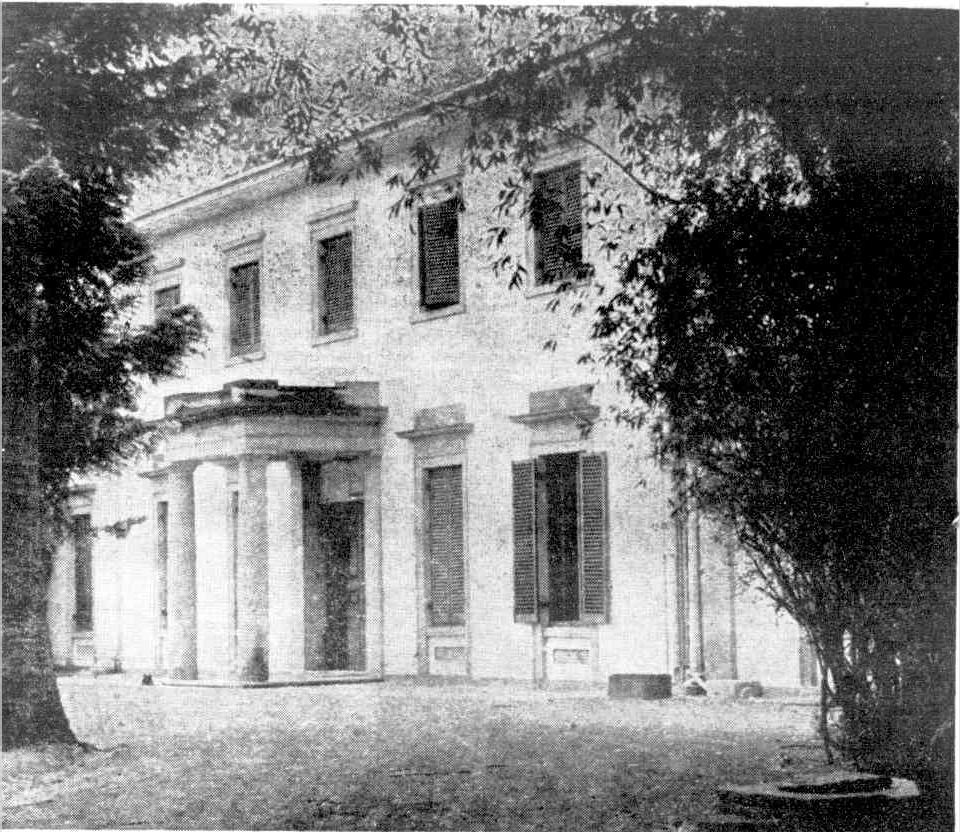
JOHN MACARTHUR'S house, which was built about 1810. Originally made of slabs, with a shingle roof, the house. has been completely repaired with weatherboard and corrugated iron. Until recently the house was used as the Estate's office, and so the inside has been completely altered.
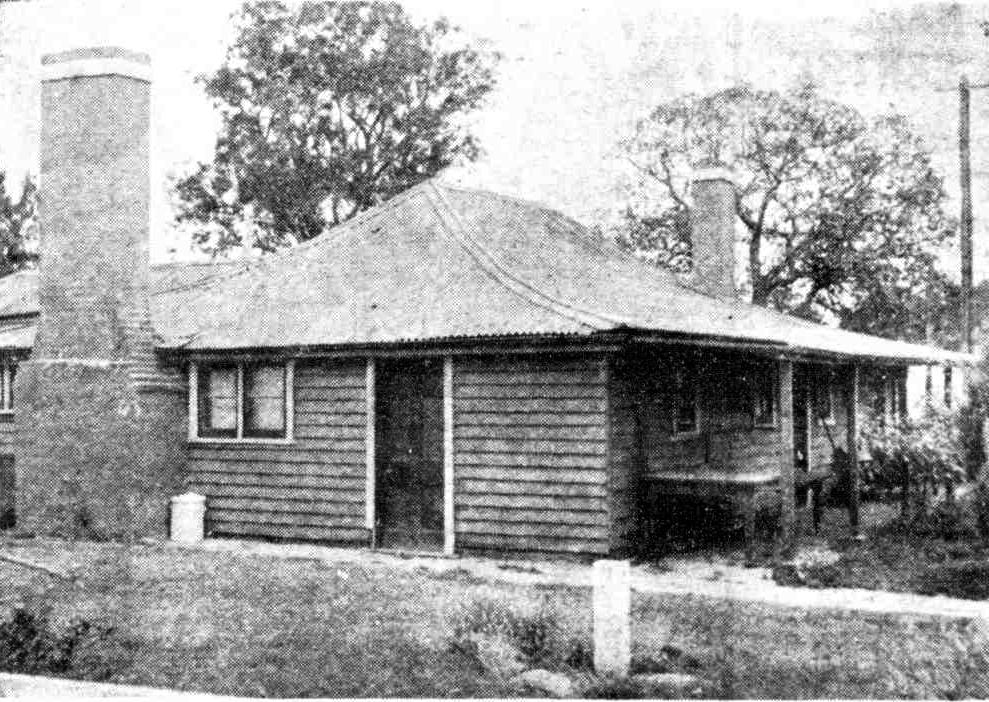
PART of the original stables a wide, bare yard, which face John Macarthur's house across Every morning these stables witnessed the impressive sight of 50 or 60 horses horses being harnessed into teams for the day's work. Now the stables are used as hay stores.
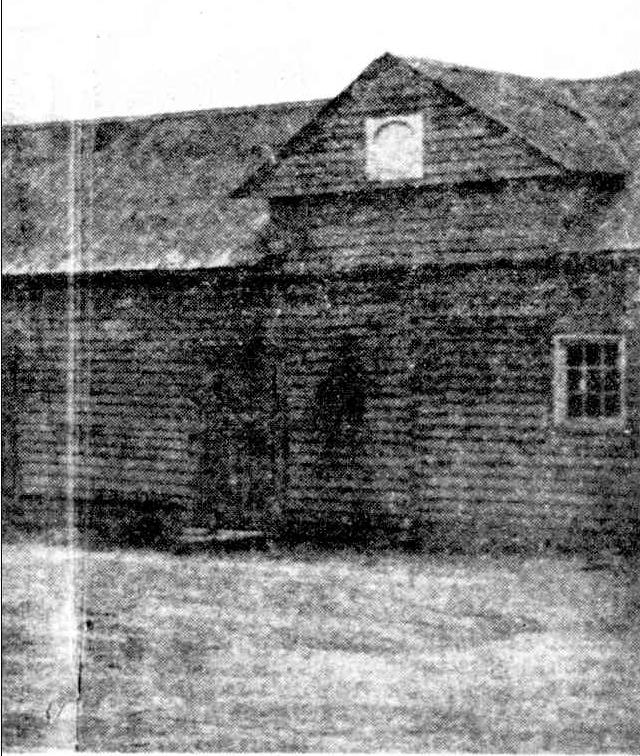
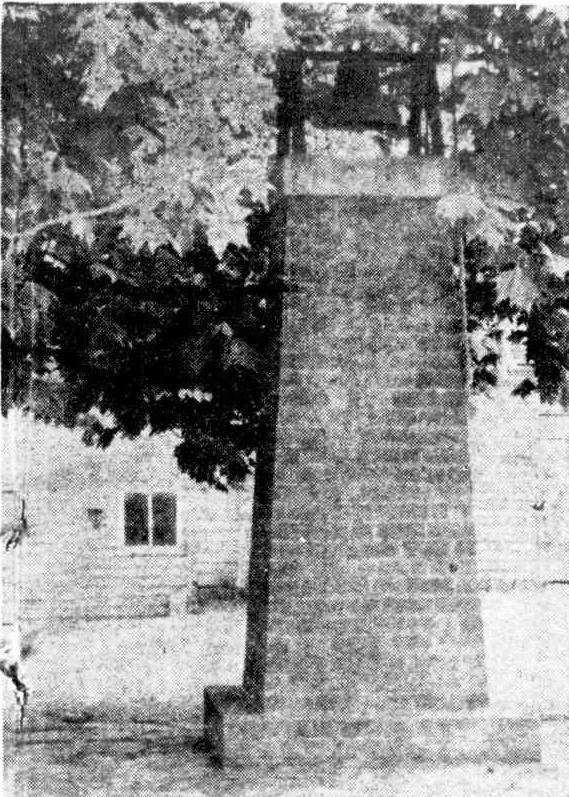
STANDING just in front of John Macarthur's cottage is this old bell, which called the farm laborers to work and tolled when it was time to return home. Legend has it that the bell-ringer pulled so hard one day the original wooden frame collapsed, and the brick tower was built in its place.
PORTION of the garden at the rear of Camden Park, which now houses John Macarthur's great-great-great granddaughter, Lady Stanham, and Sir Reginald Stanham. Lady Stanham's grandchildren, the family's seventh generation, live in the north wing.
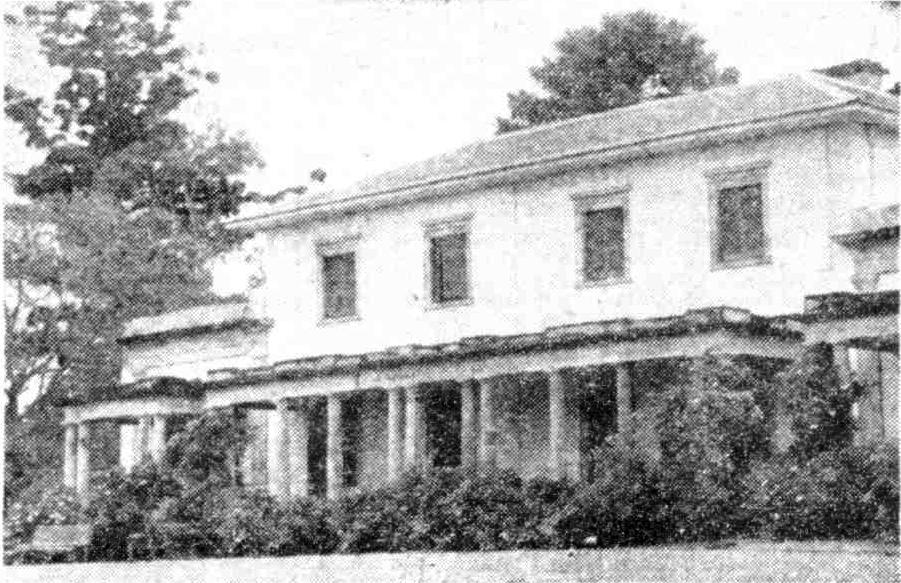
ST. JAMES' Church, chapel of the Macarthur family, on the estate at Menangle. The nave teas built in 1876 by Mrs. Elizabeth Macarthur Onslow, granddaughter of John Macarthur. She had the chancel and steeple added in 1898.
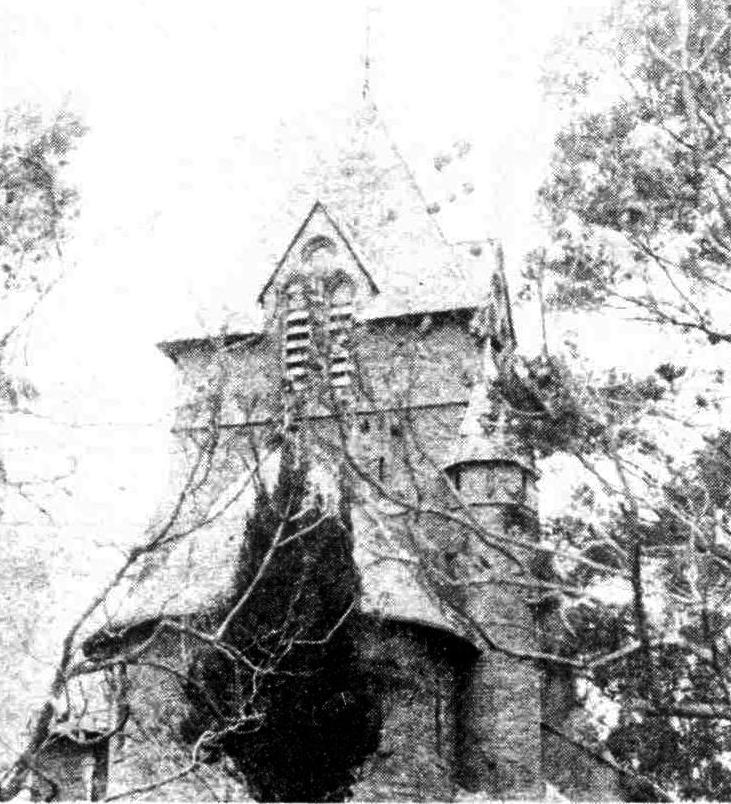
CAMDEN PARK (1953, November 27).The Farmer and Settler (Sydney, NSW : 1906 - 1955), , p. 24. Retrieved from http://nla.gov.au/nla.news-article122989823
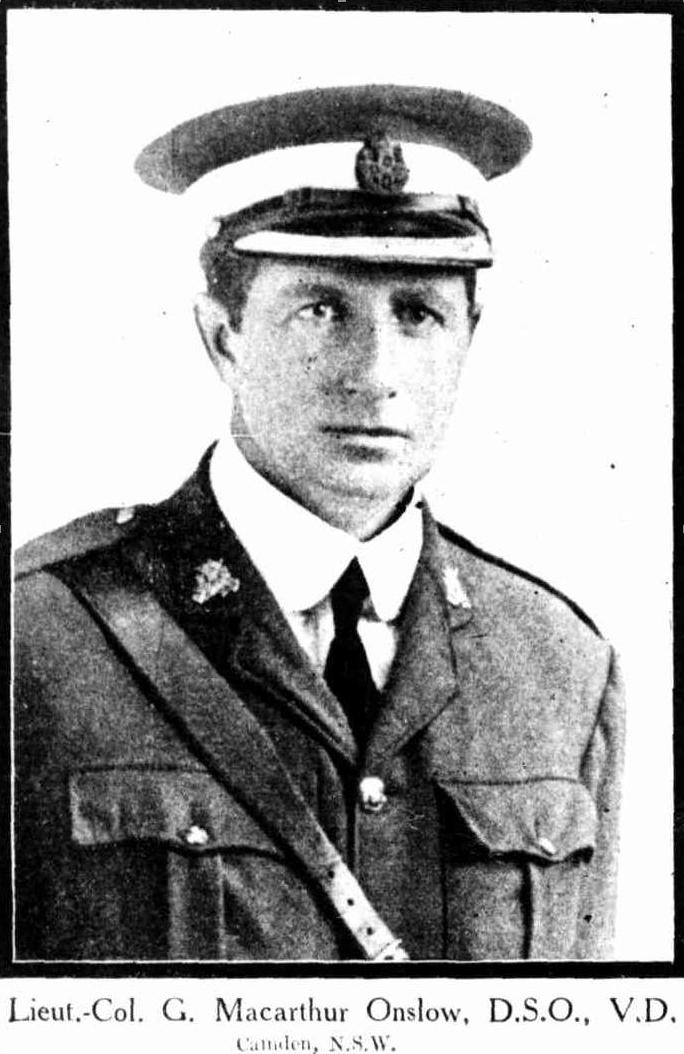
St John's Camden - sample of previous Articles and insights
Consecration of S. John's Church, 1849.
The 7th June, the day fixed for the consecration of St John the Evangelist's 'church at Camden, was most auspicious in point of weather, being one of the finest of our fine winter days, and by ten o'clock every road and footpath leading to the village was dotted with men, women and children, wending their way to the scene of the appointed ceremonial. The building itself stands very conspicuously on a rising ground, a little to the left of Camden, and its graceful and really well proportioned spire presents a cheering object to the up-country traveller as it breaks the dull outline of bush hills, carrying the mind back to scenes well remembered and dearly loved by English hearted folks. Shortly after eleven o' clock the Bishop arrived at the church, and was received by Mr. William Macarthur and the Churchwardens at the west door. Here the petition for consecration was read and received. The service then began; the Bishop, followed by the attendant clergy, reading, as they went from porch to chancel, the 24th. Psalm, by alternate verses. The Revs. Thomas Hassall and Robert Forrest acted as Chaplains, the Rev. George F. Macarthur as Chancellor, in that capacity reading the sentence of Consecration. The Rev. Edward Rogers, the incumbent of the church, read the Morning Prayer, and assisted at the administration of the Holy Communion. The Lord Bishop preached the sermon from Gen. xxviii 16, setting forth the doctrine of holy places, and the practical benefits which they were the means of imparting to those who rightly estimated and used them. Many of the laity, we were glad to observe, remained to partake of the Holy Communion, and the demeanour of the whole congregation was devout and reverential. The old version of the 84th Psalm to Bedford tune, and the Old Hundredth, were sung by the whole congregation with a really solemn and devotional effect, being led by the simple melody of a well-toned flute, and presenting a very admirable example for all country congregations. The alms collected amounted to about £13 10s. The clergy present besides the incumbent, were the Revs. Thomas Hassall, R Forrest, H. I. Stiles, J. Walker, H. H Bobart, W Stack, H. D. D. Spalling, G Vidal, W. H. Walsh, T. H. Wilkinson, James Hassall, J Broughton, and G. F. Macarthur We add, as a rider to our report, the following extract from the communication of the Camden correspondent of the Sydney Morning Herald, which appeared in that paper a fortnight after the consecration and which will be read with much interest and satisfaction': —
' The congregation at the Camden church on the two Sundays since its consecration, has numbered two hundred or more: this is very well. Since that day the railings of the Church have been put up; they are very handsome and accord with the architecture of the building— the balustrade being intersected by carved Gothic arches. We understand that the Bishop has generously contributed more than half the expense of this work. His Lordship has also very kindly assisted our wants by sending up a number of convenient cedar seats ; the permanent seats (which are intended to be open) will be put in hand as soon as there are funds, as also the pulpit, which is to be of the beautiful colored freestone of this part of the country, obtained at the quarries of Mr. George Macleay, of Brownlow Hill. In giving an account of the opening of the Church, which it will be remembered was on 7th June inst., we omitted to mention as entirely accidental coincidence which is worth remarking. On that very day forty-four years, viz., on 7th of June, 1805, the late Mr. John Macarthur, the father of the gentleman who gave the site, and mainly raised the Church, returned to the colony from England with the first merino sheep, thereby laying the foundation of whatever prosperity it has hitherto known.' We furnish, according to promise, a few more particulars respecting the architectural features of this handsome structure. It consists of a nave, chancel, and western tower and spire, all, including the spire, being built of brick, and at some future time to be covered with plaster the spire is already stuccoed. The windows, which are of the decorated' period, are exceedingly well wrought in the stone procured from the neighbourhood, which is of a greyer color and closer grain, though softer in the cutting, than the sandstone around Sydney. The flagging of the interior is the very best piece of work of the kind in the country. The roof is open, with the beams and spandrils. The windows are filled with fancy patterns of octagon and square glass ; the former being ground, the latter colored, set in copper frames. The alter rail is carved with cinquefoil pointed arches, on small shaftes, with caps, bases, and bands, in the style of the church. and is of very rich effect There is a want of porch and vestry,. and the chancel is far too short. With these exceptions all is satisfactory, and evidences the spirit of reverential care and true devotion which we must always rejoice to see manifested in the erection of God's house of Prayer. — The Sydney Guardian. Consecration of St. John's Church, 1849. (1909, June 17). Camden News (NSW : 1895 - 1954), p. 1. Retrieved from http://nla.gov.au/nla.news-article136643958
Genesis 28:16 King James Version (KJV) - And Jacob awaked out of his sleep, and he said, Surely the Lord is in this place; and I knew it not.
Psalm 24 - King James Version (KJV)
The earth is the Lord's, and the fulness thereof; the world, and they that dwell therein.
For he hath founded it upon the seas, and established it upon the floods.
Who shall ascend into the hill of the Lord? or who shall stand in his hol place?
He that hath clean hands, and a pure heart; who hath not lifted up his soul unto vanity, nor sworn deceitfully.
He shall receive the blessing from the Lord, and righteousness from the God of his salvation.
This is the generation of them that seek him, that seek thy face, O Jacob. Selah.
Lift up your heads, O ye gates; and be ye lift up, ye everlasting doors; and the King of glory shall come in.
Who is this King of glory? The Lord strong and mighty, the Lord mighty in battle.
Lift up your heads, O ye gates; even lift them up, ye everlasting doors; and the King of glory shall come in.
Who is this King of glory? The Lord of hosts, he is the King of glory. Selah.
ST. JOHN'S CHURCH/ CAMDEN. 1891
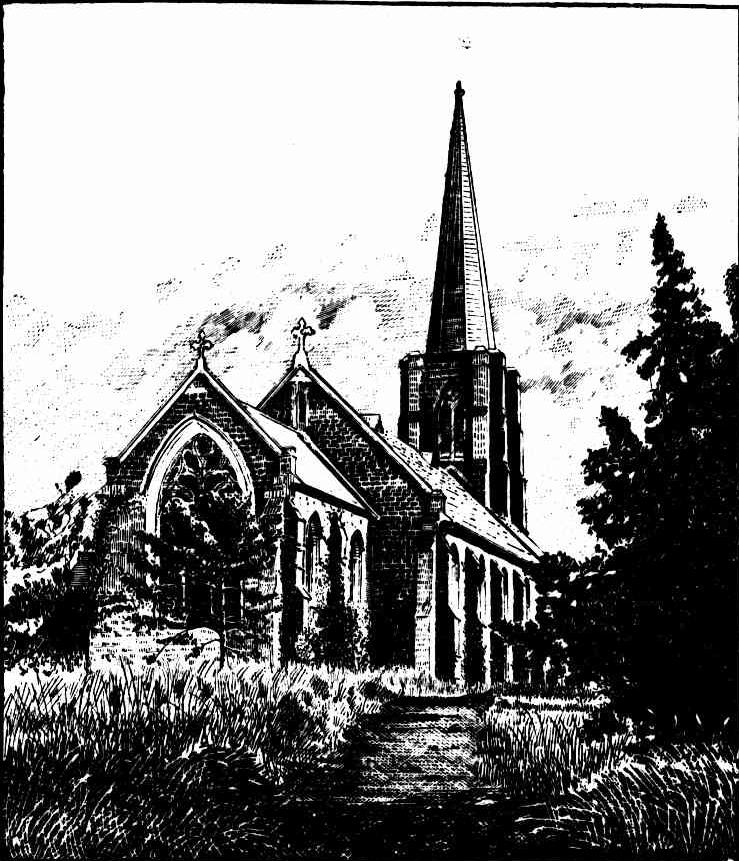
THE graceful spire of St. John's Church, at Camden, is a prominent feature in the landscape of that rich pastoral district, the home of the historic McArthur family, so intimately identified, in the deposition of Governor Bligh by Colonel Johnston. The church was consecrated by Bishop Broughton, in 1849. It is related that the selection of its designation-St. John-was suggested as appropriate to the name of its generous founder, who thus slyly became canonised without the aid of ecclesiastical Bell, Book, and Candle. The building, which is of freestone, cost £8000. The present chancel is an enlargement of the original one, and, with the east window, was erected to the memory of the late Mr. James McArthur. The window is pure Gothic, and an exceedingly handsome one, the stained glass alone costing £8300. There is another fine memorial window, erected by the friends of the late Captain Onslow, the glass of which cost £8190. The other windows are-one in memory of the Rev. Henry Lingcombe, a former incumbent, and four smaller ones presented by the late Sir George Macleay. The Rev. Dr. Forrest was the first incumbent of St. John's, since whom there have been the Revs. Edward Rogers, Henry Lingcombe, and J. P. Moran. The latter is, at present, absent on leave in England, the Rev. C. J. King in the meantime officiating as locum tenens. . St. John's Church, Camden. - (Drawing)ST. JOHN'S CHURCH, CAMDEN. (1891, December 5). Illustrated Sydney News (NSW : 1881 - 1894), , p. 5. Retrieved from http://nla.gov.au/nla.news-article63613464
ST. JOHN'S, CAMDEN. Anniversary of Consecration. (BY ERIC RAMSDEN.)
When the stately church of St. John was erected on its commanding site, high above Camden village, the Macquarie or Greenway influence had waned, and the Gothic revival had come into its own Anniversary services tomorrow will commemorate the consecration of the church on June 7, 1849.
The presence of Mrs. Crotty, wife of the Bishop of Bathurst (who will preach at the consecration festival), will lend additional in-terest to the gathering. Mrs. Crotty is a direct descendant of Rev. Thomas Hassall, the first Incumbent of the now adjacent parish of Cobbitty. Prior to the erection of St. John's, however, the whole of the surrounding countryside was included in Mr. Hassall's parish indeed his parish took in almost the whole of the State.
Thomas Hassall married Anne, the eldest daughter of the Rev. Samuel Marsden. Both rest in the peace of the tree-shaded church-yard in Cobbity. Through this marriage Mrs. Crotty can claim descent from two families distinguished in the missionary history of the Pacific. Rowland Hassall, the father of Thomas Hassall was one of the missionaries of the Dun who went to Tahiti, in 1796. When expelled from Tahiti the missionaries came to Sydney at the invitation of Mr. Marsden Thomas Hassall and his wife lived at Denbigh, near Cobbitty where Samuel Marsden was frequently their guest. The Hassalls became large landowners in the district though their properties have long since passed into other hands.
Both Thomas Hassall and his brother-in-law, Rev. H. H. Bobart of Parramatta, were waiting to welcome the Bishop (Dr. Broughton) when he arrived from Camden Park that June afternoon 84 years ago. Both Mr. James and Mr. William Macarthur, to whose "paternal liberality" the erection of the church was due, were there too. Fifteen clergy were in attendance. The congregation numbered 500. Yet strange to say-and the historian must be truthful-the collection did not total more than £13/15/1. An ecstatic scribe who was present on this occasion after making pointed reference to the collection added "All nature seemed to smile upon us and the bright gleam of sunshine which fell as we were leaving the churchyard will long shed a halo over recollection and characterise this as the fairest holiday which has ever blessed the rising village of Camden. "
DISCOVERY OF NEW SKETCH.
Early records of St John's are rather scrappy.
Presumably, a considerable period elapsed between the commencement of the erection of the church and its consecration Readers of " The Herald" were informed in 1840 that "we have been gratified by the inspection of a design for the proposed village of Camden the site for which has most eligibly been chosen on the tableland which overlooks the Nepean River, immediately in the vicinity of the Cowpastures Bridge, on the present line of the Razorback-road. On the greatest elevation of the adjacent hills, it is proposed to erect a church. . . "
It was placed on record by Sir Willlim Burton that, in the same year, preparations 'were in a state of considerable forwardness for the erection of a church. The reproduction on this page of a sketch by Lieutenant Woore, R N., of the church and village in 1842 is therefore of considerable value. The drawing (which is reproduced with the permission of its owner, Mr. T. W. F. Busby the naval officer's grandson) shows that the tower was in position that year. For a time Lieutenant Woore lived at Harrington Park, a well-known property between Camden and Cobbitty. It was at this period that he made this and other drawings of the neighbourhood.
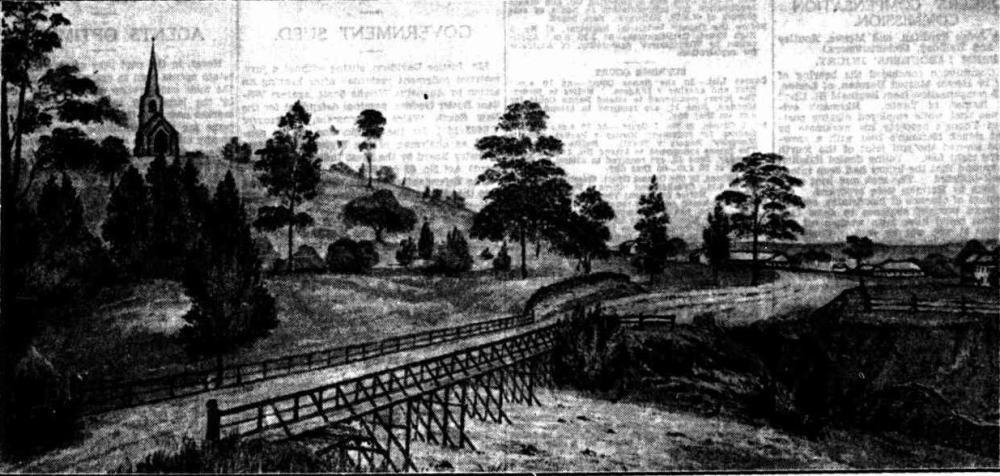
Captain J. H. Watson FRAHS in an article In the "Sydney Diocesan Magazine" in October, 1925, stated that the original building was designed by William Mortimer Lewis the Government architect "but that E. T. Blackett who arrived in 1842, appears to have the work after." Local tradition, however, ascribes the honour to Gilbert Scott (whose nephew, Sir Giles Scott, was the architect of Liverpool Cathedral).
The first entry in the earliest book of parish records in the possession of the present rector, the Rev. T G Paul, refers to the burial of Thomas Budd of Narrellan, on March 25, 1843. The Rev. Robert Forrest, the first rector (afterwards headmaster of The King's School), was then in charge. The first couple to be married in the parish were Joseph Ray and Jane Burnside, both of Camden on November 29, 1843. The rector believes, however, that Robert Boyd, of Cam-den, and Augusta Sheather, of Camden Park on February 24, 1848, were the first couple married in the church. The first marriage after the consecration was undoubtedly that of Thomas Dunk and Maria New, of Camden, on June 13, 1849. The bride was an aunt of Mr. Charles New, the present verger of St John's. The first baptism in the parish was that of Jane Marian Lodge, of Narellan, on April 16, 1843.
The site was given by the Macarthurs, who in the course of years, have beautified the church in many respects with memorials to members of their family. The foundation stone was laid on November 3, 1840. At the consecration nine years later Bishop Broughton was attended by the Revs. Thomas Hassall and Robert Forrest as chaplains. The Rev. George F Macarthur read the sentence of consecration. The Rev. Robert Forrest was in charge from 1843-47, being succeeded by the Rev. Edward Rogers (1848-58), the Rev. Henry Tincombe, 1858-72, the Rev. John F Moran, 1872-92, the Rev. Cecil J King 1891-1927, and the Rev. Thomas Giles Paul, 1927.
The font was the gift of Mr. William Buchan, "a talented mason and sculptor re-siding in the village," in the early forties and was regarded "as a handsome gift from a poor man." The stone came from the quarry at Denbigh. The altar rails were the gift in 1850 of Dr. Broughton, Australia's first bishop. Mrs. Macarthur Onslow presented the clock and eight bells in 1897. The large tenor bell, weighing 14cwt, is inscribed with the doxology. Friends and parishioners erected the beautiful lych gales in 1912 to Mrs. Macarthur Onslow's memory.
FLOODLIGHTING OF TOWER
The church was electrically lighted in 1931. The floodlighting of the clock and spire is in memory of Brigadier-General George M. Macarthur Onslow. The memorial was given by the officers and men of his old regiment the 7th Light Horse.
Mrs. Samuel Wheeler, the oldest parishioner, preserves an interesting link with the past. Her husband came to Australia with his father, the late Jonathan Wheeler from Gloucester, in 1838. The Wheelers were sawyers. They were brought out by the Macarthur family for the purpose of preparing the timber for St. John's Church. The finest of the ironbark trees in the district were placed at their disposal. How splendidly the Wheelers, father and son used their material, can be seen in the roof of the church today nearly a century later. The woodwork throughout St. John's has been handled with exquisite craftsmanship. Samuel Wheeler died in 1909, aged 94. His widow, though now in her 90th year, still walks up the hill to service.
Another of St. John's beauties is its brick-work. Lovers of this almost lost art always admire it. The bricks were made in Camden, not far from the church. It is said that the builder Richard Barsden, ordered the excavations to be filled in when he had sufficient bricks made for the building.
The present churchwardens are Major General J. W. Macarthur Onslow and Messrs. John Veness Robert Cuthel with Mr. A. H. Croaker as honorary treasurer. ST. JOHN'S, CAMDEN. (1933, June 10).The Sydney Morning Herald (NSW : 1842 - 1954), , p. 9. Retrieved from http://nla.gov.au/nla.news-article16978921
St. John's Church of England, Camden. 80th Anniversary. On Sunday, June 9th, the Parish of St. John's, Camden, celebrated its 80th Anniversary. The Festival commenced, with Holy Communion at 7.45 a.m., the Celebrant being the late Rector of the Parish, the Rev. C. J. King, M.A., who was assisted in the Sanc'tury by the present Rector, Rev.rtT. G. Paul, Canon Garnsey, and Rev. A. F. Pain (Cobbitty). The attendance at this service was very good. At 9.30 a special Children's Service was held many children from outlying centres attending.. It was an inspiring sight to witness so many young worshippers gathered together in the old Church. The Service took the form', of a shortened Mattins, and the choir- was composed entirely of boys from the Sunday School. The address was given by the Rev. C. J. King, who placed before the children their responsibility of carrying on the work, not only in this Parish but in the Kingdom o£ God throughout the world. After the blessing the children, lead by the boys' choir, formed a procession of witness, and marched round the church, being finally greeted at the door . by Mr. King, who was greatly loved 'by the children.
The chief service of the day's celebrations was at the eleven o'clock Choral Eucharist. Many extra seats had been procured and were placed in the body of the Church, and also in the Chancel. By the appointed time a huge congregation has assembled which packed the large building to the doors. Every centre of the Parish being well represented. The Eucharist began with the Processional Hymn, 292, followed by the Introit, Psalm 43. ? At this service, the Rector was the Celebrant ; the Rev. Dr. P. A. Micklem, D.D., Rector of St. James' King Street, Sydney, acting as Gospeller, and the, Rev. C. J. King as Epistoller.The sermon_was preached by Dr. Micklem who took for his text Matthew V., 14, 'A City set on a hill cannot be hid.' 'Just as St. John's Church, Camden, dominated ttni countryside with its silent witness, so should the spirit, of our religion dominate the whole district with its gentleness and spirit 'of service,' said the Doctor, 'There are . many ways of getting in touch with God, by service to our follow men; by loving care of God's property, and the Sacrament of the Altar. It is here that we offer every bit of work done, as work done for Christ ; here all our efforts are sanctified and blessed, and gathered together i.nto one sacrifice which we are. bound to offer. By 'our works men will know us ; then come to know our Church, and finally to know Him as Lord of all. We must let our light so shine before men that' they -may see our good works and glorify' our Father which is in heaven,' continued the preacher, 'The world was looking to the Church for a beacon and guiding light in dark days; we were as a witnessing city set on a hill which could not be hid.' During the Communion Mrs. Brien, who presided at the organ; played appropriate music.
Festal Evensong and Sermon marked the close of a wonderful Anniversary. In spite of a bitterly cold night the attendance was large. The Rev. T. G. Paul took the service and the address was delivered by the Rev. C. J. King. The choir rendered the Anthem 'Lift. up Your Heads.' In taking for his text Ephesians 111. 20-21, the late Rector said that 30 years ago we celebrated the Jubliee of the Consecration of St. John's Church, on Wednesday 7th June, 1899. Dr. Camidge, then Bishop of Bathurst, preached the Sermon, and Revs. T. V. Alkin, G. H. Allnutt were present with Rev. J. F. .S. Russell and himself. The service was followed by' a luncheon in the Drill Hall and an Organ Recital in the afternoon, and tea in the Hall in the evening. Mr. J. K. Chisholm gave the .principal ad-, dress, in proposing the toast 'The Parish.' This was seconded by Mr. J. Lakeman. His Grace the Archbishop of Sydney, preached on the following Sunday. These two Bishops, and two of the Clergy have passed on to their rest and higher service. The trouble in South Africa had taken away even then, many of our men, but the church still car, ried on. Twenty years ago to-day, there was a meeting of Parishioners to celebrate the Diamond Jubilee of St. John's, three of the speakers on that occasion have passed within the veil— Canon Allnutt, Mr. Lakeman, and Mr. F. W. A. Downes. Twenty years on from to-day, I presume the Parish will be celebrating its Centenary, who of today's speakers and friends will be present then ? God knows ! The last twenty years 'have seen stirring times, times of war, of flood., of famine, wonders of inventions, flying, wireless, etc. Many running to and fro' and knowledge increased. The map of the world has changed and is changing. But-4like the Faith' once delivered to the ;the Saints— which does not alter— for 80 years past- the old Church has stood— its finger ever pointing up to God's Heaven — a silent but eloquent speaking witness to the unchanging God of Love, Mercy, and Truth. And the Bells, their chimes, their witness In their holy place on high, Fulfilling day by day their Mission -Midway twixt the earth and sky. As the birds sing daily Mattins, To the God of Nature's praise, There their nobler daily music , To the God of Grace do raise. And when evening's shadows soften Chancel, Cross and Tower and Aisle, They shall blend their vesper summons With the day's departing smile. Christian men shall hear at distance, In their toil or in their rest, , Joying that in one communion Of one church, they too are blest. Ten years ago the epidemic of 'flu' was raging, so that although the Church Services were continued each Sunday, there could be no public gathering, to celebrate the 70th Anniversary, but it was commemorated by the publishing of a small history of the Parish, to which an addition was made 5 years ago — perhaps another may be added today to keep the record up to date. We not infrequently see letters and articles in the daily papers praising the picturesque scenery of the district and the beautiful situation of our church, but to me the chief glory consists in the use made of it. Ever since the 8-days' Mission conducted by Canon E. C. Beck in' 1894, daily services have been the rule— held once a day, if not twice. The church is open day and night, and many a child of God has found a few minuets 'quiet prayer or rest in their Father's House, a time of refreshment' and peace. ' No wonder that there is a deep feeling of love for the dear old church in many hearts. This love has shown itself lately in the generous offerings given for its repair, and in this way we are following in the track blazed by those great men who built the church, and of that Saint of God who gave the clock and bells, and in whose memory the beautiful Lych Gate was erected, Mrs. Elizabeth Macarthur Onslow. 'Time avouch fall me,' said Mr. King, 'to try and mention all the old families whose people helped to build, support, and advance God's Kingdom in this Parish in the past. We who today worship here, thank them, and pray for their peace and rest, as Ave enter into -.their labors. A feature of this church and Parish which to-day is so inspiring is that though 80 years or more old it is still progressing and advancing; more Communions have been made of late; more money given than ever before, at least since 1849. God grant that the young people of to-day, nay the very boys and girls, may determine to carry on the work here for God, faithfully and generously and with loving hearts.' The late Rector struck a note of warning when he said : 'You are blest in your present Rector, uphold him in every way,' or some Parishes who are envying you already may try tt) call him away all too soon.' Continuing his address, Mr'. King said that many a clergyman and layman looks back with affection and gratitude to their work here, from all over Australia. 'Who will follow the example of the Murrays and Bishop Wilton,' said Mr. King, 'who offered and went to the Mission Field ? What boys or girls will dedicate themselves to the work of the Church, at home or abroad ? Who, hearing the call as the young Isaiah did, will answer: 'Here am I, send me' ? God bless you, dear Pastor and people of this Parish, and in the day when He maketh up His jewels, may you and I be found amongst those who have washed their robes and made them white in the Blood of ,The Lamb, and stand and serve for ever before the Throne of Him who — once the Carpenter of Nazareth, now lives and reigns King of Kings and Lord of Lords— and yet everyday, our Master, Lover, Friend, and Comrade.
At the close of the Service, instead of the Vesper Hymn, the whole congregation stood and sang the Te Deum Laudamus as an act of thanksgiving for many blessings received. The Festival closed with the Benediction which was pronounced by the Rev. C. J. King, the congregation leaving the Church to the strains of the Halleluiah Chorus, played by the Organiste, Mrs. Brien. St. John's Church of England, Camden. (1929, June 13). Camden News (NSW : 1895 - 1954), p. 1. Retrieved from http://nla.gov.au/nla.news-article136636853
Sketch from ST. JOHN'S CHURCH, CAMDEN.
Situated on the top of a hill near the town, it is the most conspicuous landmark for miles around. ST. JOHN'S CHURCH, CAMDEN. (1930, March 5).Sydney Mail (NSW : 1912 - 1938), , p. 56. Retrieved from http://nla.gov.au/nla.news-article160633242
St. John's Musical and Dramatic Society, Camden.
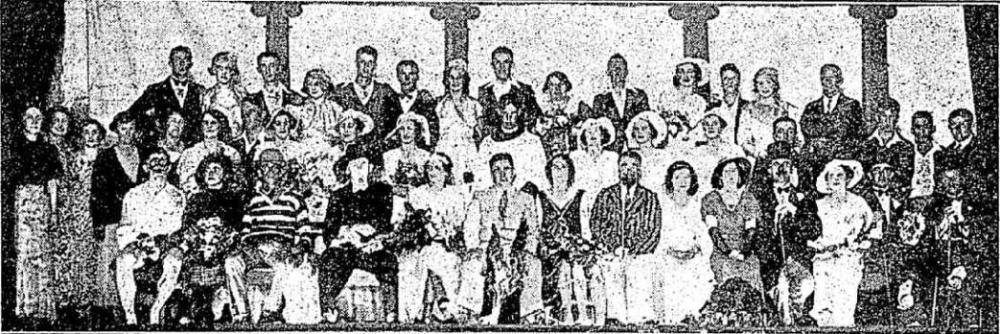
Back row standing, reading from left to right. — Ted Rapley, Mary Poole, Eric Pinkerton, Niita Kelloway, Jack Wheeler, Ralph Larnach, Joyce Blackburn, Cecil Cranfield, Ruby Fordham, Allan Rix, Dora Fordham, Will Coates, Lily Gibson, Mr. White. Second Row. — G-wen Gaudry, Miss Smith, Dorothy Pope, Mrs. Brien, Mrs. McKenzie, Irene JBootie, Bob Mawdsley, Daphne Cuthel, Marjory Morgan, Ruby Duck, Alan Stuckey, Ina Rideout, Dorcas McMinn, Ruth Larnach, Percey Gross, Mr. White Jr., Con Fuentus, Ross Wheeler. Front row seated. — George Watson, Nita Rapley, Vic Taplin, Les Pinkerton, Ella Watson, Rev, R. A. O'Brien, Vi Wheeler, W. Pattison, Maisie Pattison, Madge Pattison, P. McKenzie, Lottie Pope, Aub Watson, A. Hayes.St. John's Musical and Dramatic Society, Camden. (1934, December 20). Camden News (NSW : 1895 - 1954), p. 1. Retrieved fromhttp://nla.gov.au/nla.news-article140483541
THE first impression of Camden, named after the Secretary of State, Lord Camden, who encouraged Macarthur in his sheep venture, is St. John's Church. The church stands at the top of the hill on which the town is built, and, from whichever direction Camden is approached, it stands high and clear over all the other buildings in the town. The river skirting Camden on the Sydney side winds across the bottom of the picture like a finishing stroke an artist has put to his masterpiece.
The Church of St. John, which will be 100 years old in 1949, is built of bricks exclusively drawn; for the pit from whence they came was filled in so that there would be no other bricks made of similar material.
English workmen were imported by James and William Macarthur to build the roof and other timberwork in the church, and these stand to-day to perpetuate the beautiful and skilled work of those tradesmen.
The stained glass window in the chancel erected by the people of the district as a testimony to James Macarthur is one of great beauty and irreplaceable value. Throughout the church there are many other memorials to the Macarthurs and Onslows, including nave windows, the bells which chime from the clock tower every quarter of an hour, and the attractive lych gate erected to the memory of Elizabeth Macarthur Onslow.
The house which John Macarthur built at Camden Park is two or three miles along the main highway from the church. However, he did not live in it, and the cottage which he occupied still stands nearby on the estate today.
Another point of historical interest in Camden is the grave of King Billy, the aboriginal "king" of Burragorang, which is to be found in the Roman Catholic Cemetery about a mile along the Cawdor road. The old headstone is cut in the shape of a thick tree trunk, and below the inscription there are some aboriginal carvings.
Almost immediately opposite on the other side of this road, the war cemetery with its one and a half rows of neat white crosses, commemorates the names of those gallant young men who were killed in air crashes at Camden while training in the service of an Air Force that was making history only too recently. A soldier keeps them company. Those who meditate there, at the resting-place of these quiet heroes, will offer a silent prayer that the other half-row of crosses may never need to be completed. Down to Camden Town (1946, November 9). The Sydney Morning Herald (NSW : 1842 - 1954), , p. 6. Retrieved from http://nla.gov.au/nla.news-article18001767
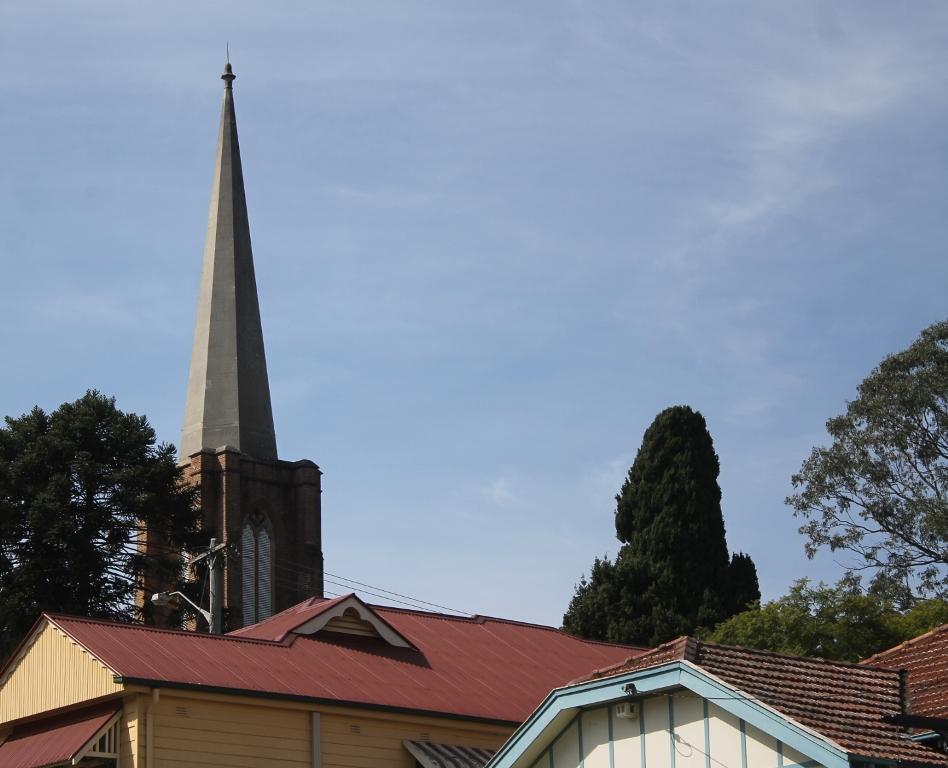
ST. JOHN'S, CAMDEN
Sir,-The author of the article, "Down to Camden Town," states that St. John's Church "will be 100 years old in 1949." I must point out that the Church of St. John, Camden, was begun in 1840, and celebrated its centenary in 1940. However, the consecration took place in 1849, and we are looking forward to the centenary celebrations of this event in 1949. As a matter of general interest it may be stated that many churches are dedicated, but not consecrated until complete, fully furnished for divine worship, and free of debt. In Camden this was achieved within nine years. A. H. KIRK. Rector of St John’s, Camden. ST. JOHN'S, CAMDEN (1946, November 14). The Sydney Morning Herald (NSW : 1842 - 1954), , p. 2. Retrieved from http://nla.gov.au/nla.news-article18002593
Lieutenant Thomas Woore, R.N
BIRTHS. On the 7th instant, at Harrington Park, Cowpastures, the Lady of Lieutenant Woore, R.N.. of a son. Family Notices (1839, July 11). The Sydney Gazette and New South Wales Advertiser (NSW : 1803 - 1842), , p. 3. Retrieved from http://nla.gov.au/nla.news-article2549367
THE SETTLEMENT AT NORFOLK ISLAND AT THE TIME OF THE MUTINY OF 1834.
H.M.S. Alligator, which conveyed the Judge to the island to try the mutineers, is shown between Nepean and Phillip's Islands. The colonial brig, Governor Harcourt, is on the extreme right. Government House is below the brow of the distant hill on the left. This hitherto unpublished sketch was the work of Lieutenant Thomas Woore, R.N. THE SETTLEMENT AT NORFOLK ISLAND AT THE TIME OF THE MUTINY OF 1834. (1932, September 10). The Sydney Morning Herald (NSW : 1842 - 1954), , p. 9. Retrieved from http://nla.gov.au/nla.news-article16911017
THE FORMER BRITISH RESIDENCY AT WAITANGI, NEW ZEALAND. |
This drawing of the Residency at Waitangi, by Lieutenant Thomas Woore, R.N., of H.M.S. Alligator, which is reproduced for the first time, is believed to be the earliest yet discovered. It depicts the home of Mr. James Busby (recently presented to the people of New Zealand by is the Governor General, Lord. Bledisloe), In 1834. THE FORMER BRITISH RESIDENCY AT WAITANGI, NEW ZEALAND. (1933, May 6).The Sydney Morning Herald (NSW : 1842 - 1954), , p. 9. Retrieved from http://nla.gov.au/nla.news-article16965363
"OLD SKETCH-BOOKS. New Zealand Incidents. (BY ERIC RAMSDEN.)
For almost a century the sketch books of Lieutenant Thomas Woore, R.N., formerly an officer of H.M.S. Alligator, and in the years of his life a pioneer settler in the Goulburn district, remained in his possession, and in the custody of his family. Although he participated in two historic events in these seas in the early part of last century, his books, hitherto, have not been available to students.
Lieutenant Woore was on the Alligator when Mr. Justice Barton was conveyed from Sydney to try the Norfolk Island mutineers in 1834. A few weeks later he was off the New Zealand coast In the same vessel attempting the rescue of Mrs. Guard, her two children and some sailors from the wrecked whaler Harriet. A talented draughtsman, the naval officer used his pencil with considerable skill and to excellent purpose on both occasions.
There are other sketches, apart from the valuable New Zealand series, in the books which, despite their age, are In a remarkably good state of preservation. Their present owner, Lieutenant Woore's grandson, Mr T. W. F. Busby, has courteously permitted me to take notes from them. Ports of call in the earlier career of his grandfather in Ceylon, India, Straits Settlement, and the Dutch East are depicted; also others after Mr. Woore made New South Wales his home, including Impressions of the Goulburn district, where he settled, Camden in the early forties, and scenes around Sydney.
In the Mitchell Library is a reproduction of a woodcut of Pomeroy, dated 1875, Lieutenant Woore's seat on the Wollondilly, near Goulburn. There he lived the life of a country squire in a beautiful old home in the English style, years later, of course, after the incidents to which I shall make reference. He died Sydney in 1877 at Redleaf, the old mansion still standing at Edgecliff. For many years Pomeroy has been in the possession of Dalglish family (of which Admiral Daglish is a member)…. "OLD SKETCH-BOOKS. (1932, September 3). The Sydney Morning Herald (NSW : 1842 - 1954), , p. 9. Retrieved from http://nla.gov.au/nla.news-article28031875
Harrington Park - an inland Sanctuary for Seafaring Men
As indicated above, one of the reasons Mr. Woore was at Camden in time to sketch the St. John's Church in 1842 was the birth of his son at Harrington Park in 1839, soon after he had 'come ashore' permanently.
Another historic place, Harrington Park, a few investigations began the ‘how, who, when and why’ of the naming of Harrington Park brought up items of a possibly piratical nature as well as connections back to Camden through the Hassall family:
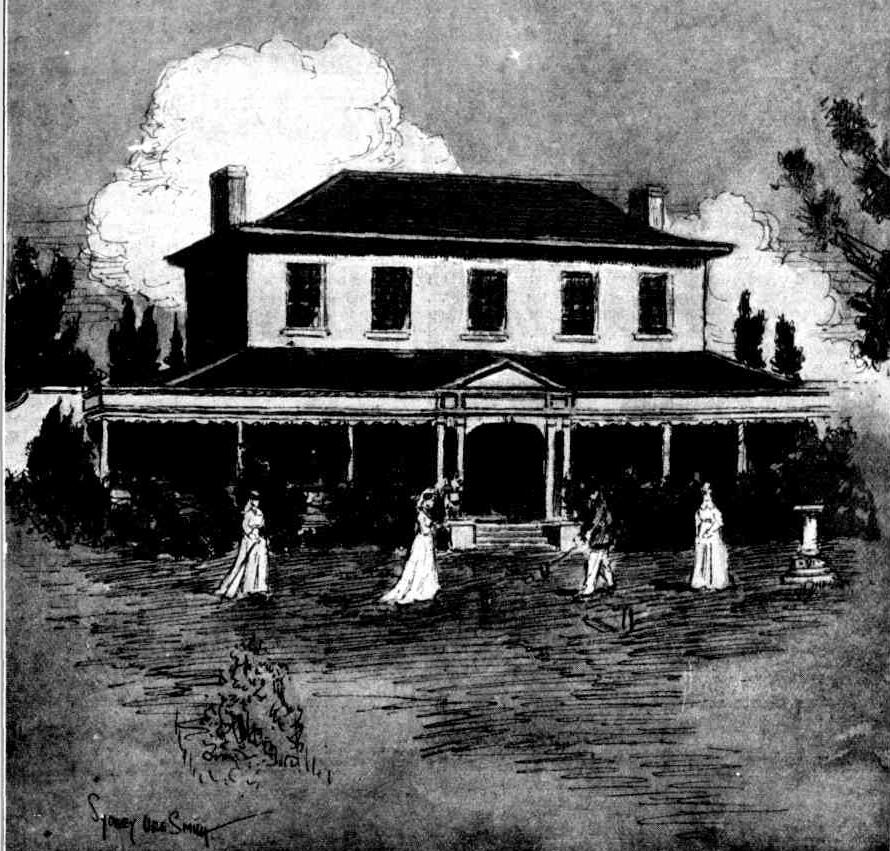
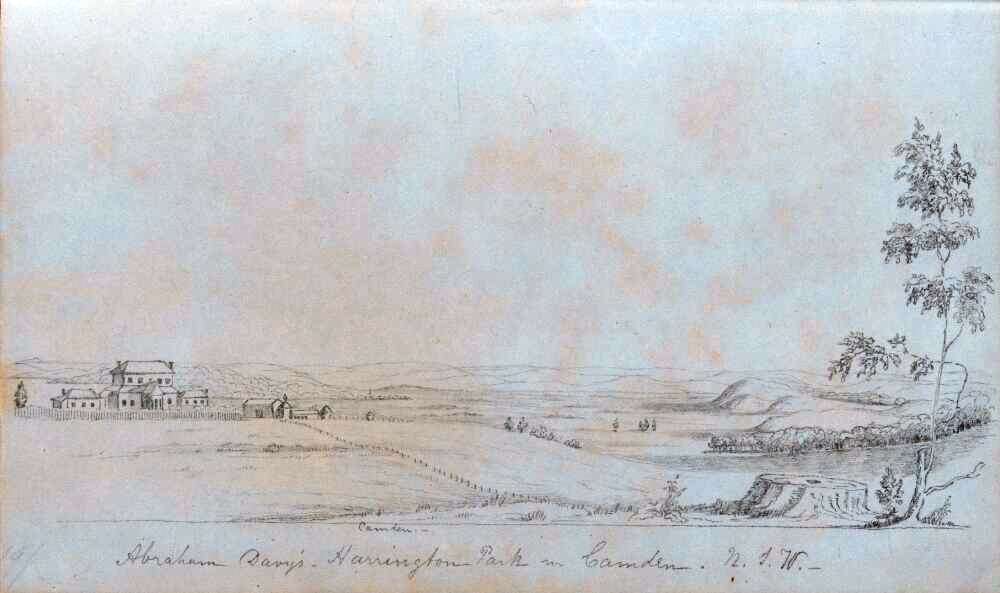
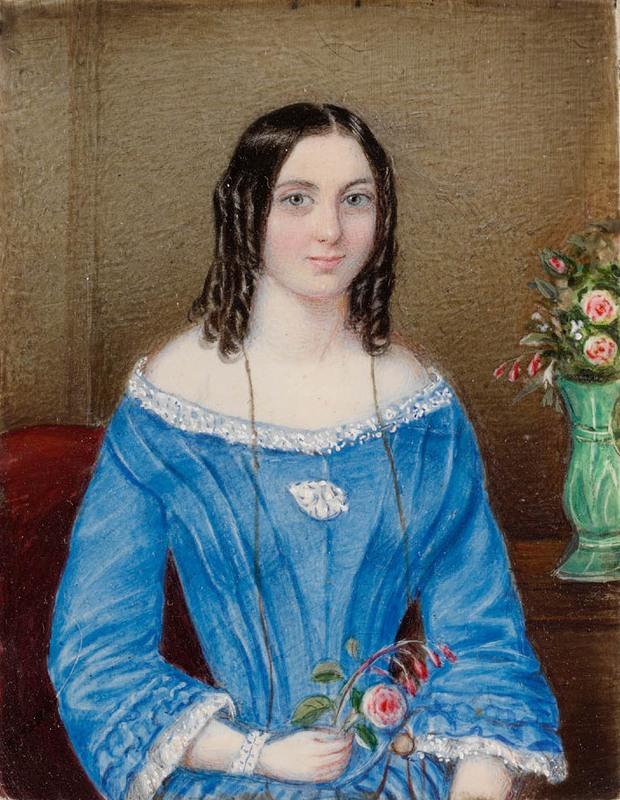
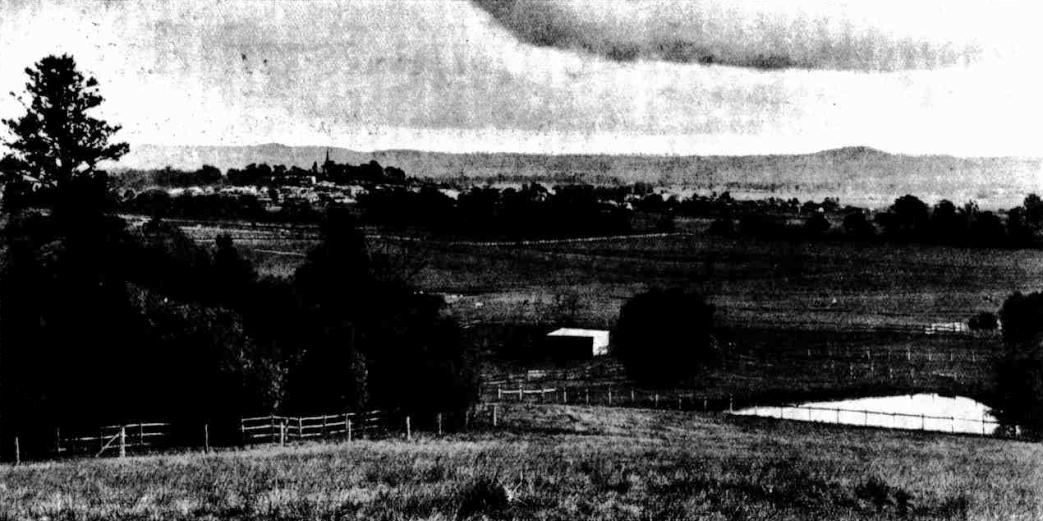
View of Camden from Near Narellan
The Camden district, a rich dairying and farming district, also has many historical associations, being originally known as the Cowpastures. The view shows (in the left-centre) St. John's Church, which was completed in the early forties. View of Camden from Near Narellan (1934, March 14). Sydney Mail (NSW : 1912 - 1938), , p. 12. Retrieved from http://nla.gov.au/nla.news-article166102260
A TOUR TO THE SOUTH
(BY OUR SPECIAL CORRESPONDENT.)
No. 1.—NARELLAN, CAMDEN, APPIN, BULLI.
THE preparations for my journey, involving a ride of some four hundred miles, were of a most sudden and not very agreeable character. As is generally the case, the horse that I was to ride could not be got in for several hours, and when he was at length secured, the saddle I was to have taken had been lent, and, of course, had not been returned, so I had no alternative but to buy one, as well as bridle, saddlecloth, and straps. All this caused the delay of a day. When the saddle was placed on the horse next morning, it was discovered that the animal required shoeing, for, in the shoes then on his feet, competent judges pronounced it impossible to travel five miles without his becoming lame. Another half day was thus lost before I succeeded in getting away. Having soon recovered my temper when once on horseback—I never know any man who could keep surly very long on the back of a good horse-the first day I travelled very pleasantly,— but as part of my journey lay through country which has often been described, I will not go into further details, than to say that it lay through Parramatta (15 miles), Liverpool (21 miles), Denham Court (33 miles), and that I arrived at Leppington-hill and Estate, 33 miles from Sydney, in the evening. This estate is about 700 acres in extent, and the house is of two storeys, situated on a hill in a commanding position above all the adjacent hills ; consequently, a splendid view, embracing many miles of country, may be obtained. Sydney can be clearly discerned on a fine day, and on the night of my arrival the glimmering red light of the Sydney lighthouse was plainly visible. Leppington is used principally for pastoral purposes, viz., for sheep, a few horses, and dairy cows, though sufficient hay is grown for home use on the estate. It is occupied by James Payton, Esq.
Next morning, I rode over with Mr. Payton to Mr. Alexander Munro's farm, about a mile distant, in order to see the sugar operations which I heard were being carried on there under Mr. Holland's (the "Planters' Friend") instructions. The first year, Mr. Munro planted a few rod of ground with Planters' Friend, to see how it would take. In consequence of its doing well, two acres were planted last year, and about an acre of splendid cane was crushed. It yielded a ton of syrup, but, unfortunately, Mr. Munro has not yet succeeded in properly granulating it, owing, it is thought, to the primitive machinery available. The crushers, &c., erected are really creditably constructed, considering the appliances at hand. Mr. Munro and his sons are still sanguine of ultimate success, and intend to pursue the undertaking as soon as opportunity presents itself.
Passing a number of small farms to the left-many under cultivation, some being ploughed, and others already looking green—I entered the gates of the Raby Estate, the property of William Moore, Esq. Raby (formerly Mr. Riley's) is said to be the second farm in the colony where the merino sheep were acclimatized. The house is one of the " good old times" structures, and has extensive stables, outhouses, &c. The present proprietor has not been many years in possession, but has already made many improvements. The fencing, which surrounds about one thousand acres of the estate, is decidedly the best I have yet seen in the colony, and it is not only sheep and pig proof, but it would puzzle a dog to get through it.
A little above Raby, and on the opposite side of the road, is the splendid Gledswood Estate, the property of James Chisholm, Esq., J.P. It is about 1500 acres in extent, and on it are flower gardens, orangery, and an orchard. Beside Mr. Chisholm's family residence, there are also a schoolhouse, men's huts, a number of stores, stables, and other buildings. A drive over a meadow about a quarter of a mile from the roadside, leads to the house. It is erected on a slight eminence, and the verandah partially surrounding it is almost covered with a Westeria and a Queensland Bignonia climber intertwined, which form an extremely pretty contrast in some seasons of the year. The flower garden is laid out with considerable care, and contains almost every plant and flower known. Beds of sweet violets and camellias were blooming in various parts of the garden. At the far end from the house was a trellised vinery, nearly 200 feet long, which promises a very good yield, should the season prove favourable. Pass-ing an orange grove of fine fruit, we found ourselves in the midst of a shrubbery, and proceeding along a secluded walk, emerged in front of the lawn to the right of the house, where I was shown "a new idea," at least, to me, in the arrangement of geraniums. There were a number of large beds, each planted with many varieties of beautiful geraniums in red, white, pink and other colours, arranged in contrast, one fol-lowing the other from the centre. The effect of this contrast, when in full flower, is said to be beautiful in the extreme. I left the park by an avenue which crosses a rivulet, and leads to the Camden entrance.
Another two miles on the Camden-road and the tollbar at the cross-road leading to Campbelltown and Camden is passed, and about one hundred yards beyond the toll-bar I entered a gateway by a pretty lodge, and found myself in Harrington Park, the residence of A. Davy, Esq. Harrington Park has quite an historical interest attached to it. It appears that, in Governor Macquarie's time, a vessel entered Port Jackson called the Harrington, bearing letters of marque, owned, and under the command of Captain Campbell, who was received by the Governor very hospitably, and while he was dining one day at Government House, intelligence was brought that a number of convicts had boarded the Harrington and run away with her. The Governor proposed immediate chase, but the captain knew the powers of his ship too well to expect her capture, so the idea of giving chase was abandoned, and, in recompense for his loss, Captain Campbell was persuaded by the Governor to accept a grant of land, which he selected accordingly, and called after his good ship, which, strange to say, was never afterwards heard of. Here Captain Campbell built his residence, and Harrington Park became noted for its owner's hospitality. Captain Campbell's son, Murdock, succeeded his father, but, painful to relate, was shot by a youthful bushranger, while endeavouring to capture him. For some years afterwards, the estate was much neglected, until it was purchased by Mr. A. Davy, who has transformed it into one of the most picturesque places in the district of Camden. The house is situated about half a mile from the main road, and is built on the brow of a hill. Passing through the second gates, a winding, romantic, and very shady walk leads to the main entrance of the house, which is built in the old-fashioned style, with castellated walls and numerous adjacent outbuildings. Within the hall I was shown many curiosities, and paintings of a most interesting character. Perhaps the most remarkable and worthy of mention is the original painting of "The Reconciliation," by Benjamin West ; the authenticity is undoubted. With the exception of a small lawn, the whole of the ground in front of the house, which is enclosed by a high fence, is planted with an almost endless variety of shrubs and trees. Pines, poplars, figs, bunya-bunyas, and hundreds of others, were all growing vigorously, and, viewed from a distance, with the house in the midst on an elevated position, the scene was strikingly pleasing ; and the view, opening up from between the trees, shewing a grand panorama of the surrounding country, is one of the finest that can be conceived. The more practical and useful business of farming is by no means lost sight of by Mr. Davy. There is a dairy (making capital butter), and about 200 head of cattle and 500 sheep are kept on the estate. Sufficient fodder for home consumption is grown. Mr. Davy is well known for the active part he has taken in attempting to develop the resources of the Fitzroy iron mines, and, although he has lost many thousand pounds in the enterprise, he still believes in the ultimate success of the undertaking, but considers that the great drawback is the high rate of wages demanded by miners and smelters.
The village of Narellan adjoins this property. There are about 120 inhabitants in the village, and a large number of small farms are near. There are two good stores—Mr. James Nott's and Mrs. Forbes's ; one public-house—Mr. Graham's, the Queen's Arms ; no police, a post-office—Mr. John Hartley, postmaster ; and last, though not least, a good schoolhouse. The latter I visited, and found the number on the roll amounted to about fifty, and the attendance averaged forty pupils. Mr. J. Hartley, assisted by Miss Hartley, is in charge, the former having been so for the past seventeen years. He is a very painstaking teacher, and I can fully endorse the inspector's report in testimony of the good writing, good reading, and good conduct of the children in attendance.
I regret, while visiting Narellan, that time did not permit of my seeing Oran Park; it was a great omission, but the fact that necessity has no law must be my excuse. Oran Park House is the seat of E. L. Moore, Esq., J.P., and is about half a mile north of Mr. Davy's, off the Cobbitty-road. It is, as I was assured, the most splendid mansion in this neighbourhood, and is a most conspicuous object, as it stands about forty feet high, with an obelisk on the roof, to which there is a winding staircase inside, and from which the spectator can see the country for many miles in all directions. I hope in my next journey to have the opportunity of doing it full justice.
A further ride of two miles through the same well-cleared undulating country, and the Cowpasture Bridge is crossed, and the traveller finds himself in Camden, forty-one miles from Sydney, and seemingly at the foot of the well known Razorback Range. Camden being in the centre of a large farming district, was once one of the busiest little towns in the colony till the floods, rust, and other evils did their destructive work. There are about 700 people in Camden. The first buildings passed after leaving the bridge are the two flour mills of the late Mr. Henry Thompson, who was one of the most enterprising gentlemen in the colony, and perhaps one of the least rewarded. One of the mills is said to be the most complete structure in New South Wales out of Sydney. There is one long street in Camden, where the principal business is transacted, and a few cross-streets. There are five churches and three schools in the town. The Church of England is in a very elevated position on the top of the highest hill in the place. The Rev. Mr. Tingecombe is the incumbent. The Roman Catholic Church is a very pretty structure. The Rev. Father Dillon officiates.
The Public School is under the care of Mr. Barton, the Church of England under Mr. Reeves, and the Roman Catholic school under the charge of Miss Dunsford.
The principal storekeepers are Messrs. Burrett, Thompson, Doust, and Cross. There are several good hotels. Mr. Risley keeps the Royal Oak, Mr. Waters the Crown, Mr. Arnold the Plough, and Mr. Kinane the Commercial. Mr. J. B. Martin, J.P., is also C.P.S., and senior-sergeant Bremner (a first-rate fellow) is in charge of the police. I noticed a few nice buildings, including private residences, in and about the town, but must defer a lengthened report sine die.
Leaving Camden, I had a pleasant ride towards Campbelltown—a distance of eight miles through undulating country, but, as I had to push on, I left Campbelltown on my left, and took the Wollongong road, via Appin. To canter along this road is a most enjoyable ride. It resembles an English lane in the country parts, with farms and homely cottages on the wayside. The first estate of importance is Mount Gilead, the property of E. H. Woodhouse, Esq., J.P. It is situate four or five miles on the Campbelltown side of Appin, and the house is on an eminence about three-quarters of a mile from the road. It has a most pleasing and commanding aspect. The estate is about 2000 acres in extent, divided into well grassed paddocks, pasturing over 1700 sheep, and was a Crown grant to the late Mr. Rose. The most prominent object among the buildings is a wind- mill, which can be seen I don't know how many miles away. A splendid view may be had from this windmill, which, by-the-bye, is one of the most faithfully built stone structures in the colony. A second immense stone building, erected for a steam mill, is situated below the house. It has three floors, is 120 feet long, 142 feet wide, and the stone walls are thirty inches thick. The masonry is first-class, and the magnificent ironbark beams look as if they would last for centuries. The building is now used as a store-house for hay, corn, &c., and a chaff-cutting machine is erected in one part of it. Another large stone building is used as a store, coach-house, and stables, where I saw several horses which will be exhibited at the forth- coming Agricultural Exhibition. Many important improvements have been made by Mr. Woodhouse since he came into possession of this fine estate, which, I should mention, has a half mile frontage to the Nepean River. Before the house is a fine artificial lagoon, 20ft. deep and nearly a mile round. Wild, as well as tame ducks, geese, &c., were numerous. The pride taken by Mr. Woodhouse in the management of his stock, poultry, and birds of every kind, may be gathered from the following list of a few of the things I saw on the estate :—Prize sheep, including Leicesters, Merinos, and Southdowns ; prize pigs, principally of the Berk-shire breed ; alpacas, emus, aviaries of doves, pigeons, parrots, quails, and pheasants of rare varieties. In the poultry yard were white native turkeys, from Queens-land; peahens, Cochin-China fowls, &c. Near the lake was a second yard, where eighty or ninety splendid Cochin-China fowls were kept. Along the avenue to the house, and about the windmill hill, are planted a large number of shrubs and trees, including the Kurrajong, Norfolk Island, and other pines, the Flame tree, the Moreton Bay fig, the cypress, the Spanish chestnut, &c.
A good sized kitchen garden is below the house, and besides vegetables, there are also beds of strawberries, vines for table grapes, and a large variety of choice plants. Mr. Woodhouse has also one of the largest and most varied collection of stuffed birds in the colony. It will be seen from this very condensed description, that Mount Gilead is quite a model estate. At the last Agricultural Exhibition, the following prizes fell to the lot of Mr. Woodhouse :-1st prize, L3 Challenge Cup, and Lord Belmore's special prize of L10, for best Southdown ram ; 1st prize, L3, and Challenge Cup, for best Berkshire boar ; 2nd prize, L2, Southdown ram.
About a mile from Mount Gilead is Rockwood Estate, where a lady named Clayton resides. A view of some splendid scenery may be had from here. The estate is about five hundred acres in extent—principally good pastoral country. Mr. Clayton, junior, was, as well as his neighbour, Mr. Woodhouse, lucky at the last exhibition, for out of five exhibits, he took four prizes, principally for sheep and pigs.
After a ride of about four miles, I reached Appin, a small, comfortable little township, containing one hotel (Buckley's), one store, doing a good business (Mr. Arm-strong's), three churches, two schools, and but one policeman. The Church of England and Roman Catholic Churches are stone structures, and the Congregational Church (just finished) is of wood. The Rev. Mr. Wilkinson is the incumbent of the Church of England, and Dean O'Connell the Roman Catholic clergyman.
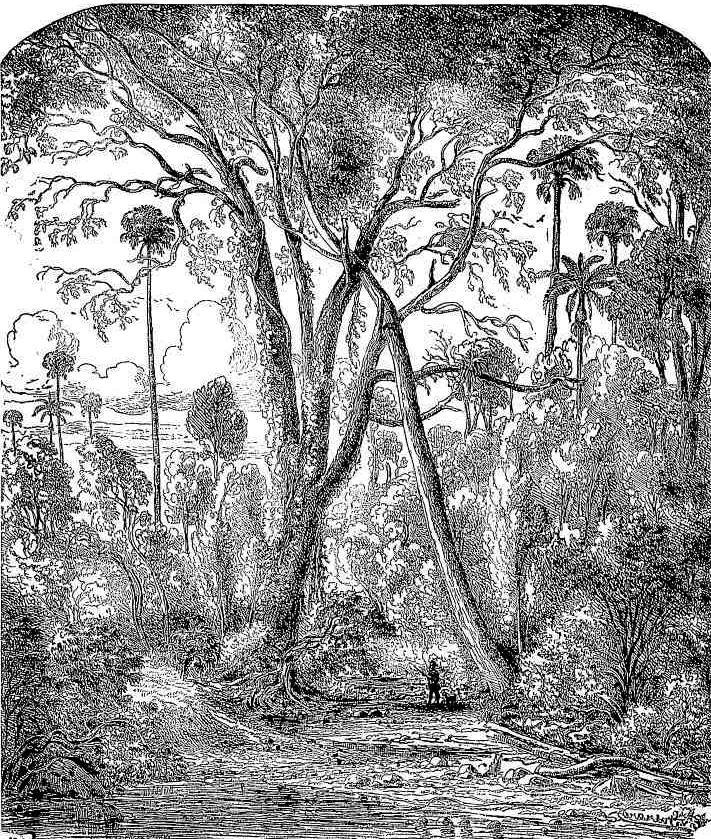
[ILLAWARRA BRUSH SCENERY.]
The public school is a faithfully-built stone structure, and has a master's residence attached. Mr. J. Poulton is head master, and is assisted by Mrs. Poulton. The teachers are very popular. There are forty children on the roll, and thirty-five in attendance. I had more than usual pleasure in noticing the cleanly appearance of the pupils, and their good order. I only had time to inspect their writing and drawing, which are really creditable. The inspector's report of the school is a very eulogistic one. Perhaps I shall be pardoned for giving the names of a few of the pupils whose good behaviour or talents came under my notice. They are: Masters Edwin Vickery, Edmund Armstrong, E. Matthews, Henry Wilkinson, Frederick Wilkinson, William Miller, George Eglington, and George Collett ; Misses Alice Armstrong, Alice Collett, Mary Brown, and Eva Platt.
The Roman Catholic school, held in a wooden building, is under the charge of Mr. M. O'Halloran. There are about fifty children on the roll and thirty-four in attendance. The discipline is well maintained, the writing fair, reading good, and their knowledge of geography and grammar generally tolerable. Mr. O'Halloran (it is right to mention) has not been long in charge of the school.
Another pleasant ride of a mile, and I pulled up at a windmill on the top of a hill on the boundaries of the town. It was erected about twenty-five years ago by the present proprietor, Mr. E. Larkin, who lives in a pretty residence near by. The mill, though in perfect working order, has not been at work since last Christmas, in consequence of Mr. Larkin having sold his right of grinding for five years to Mr. Bocking, of Campbelltown. Three miles further to the south, and I came to Broughton's Pass, with its magnificent wild scenery, dizzy chasms, and towering precipices overlooking the narrow roads going up and down. Another four miles and I arrive at Wilton village, where I found a new school-house, M'Beattie and Croghan, builders, and a small Church of England. There are pretty farms about, and above all Mr. Wanson's Broughton Park estate, on the top of the hill, famed for its rabbit warren, and its nice garden. From thence I returned to Appin, and started early next morning for Wollongong. There was very little of note on the road until I came to the Loddon River where I dismounted, and at that clear, crystal stream pulled from my valise a nice lunch which a young lady, whose consideration deserves more than thanks, had placed there on my leaving Appin.
A few miles further and I began to descend Westmascott's Pass, where the scenery is exceedingly grand, and at the same time entered into what is justly called the fertile, beautiful, and romantic district of Illawarra which extends about eighteen miles north and south along the coast.
Here I found myself in another world. Everything about was different to what I had before passed through. I cannot do full justice to the scenery, but the annexed sketch will give an idea of the character of the vegetation near the foot of Westmacott's Pass and about Bulli. It represents an open part of the brush vegetation. In the gullies and more densely covered portions, the rankness of the semi-tropical growth is such that the sun's rays are seldom seen, as the tangled vines and creepers added to the dense foliage of the giant trees, help to form an almost impenetrable shade. The exuberant magnificence of vegetable life in such situations is very striking.
It was the first time that I had had an opportunity of seeing the rich brush of the Illawarra district. The change on descending the mountain from the arid sandy hills, rocks, and stunted scrub between Appin and the top of the mountain is very remarkable ; and I certainly was not prepared for anything so different and semi-tropical in its character as the magnificent vegetation which clothed the slopes of the descent and the valleys below.
Coal and butter are the two great products of the district. Bulli is a very cosy little place, and boasts of a fine stone Wesleyan Church, in which the Rev. Mr. Fidler officiates ; a large wooden public school, a good store and post-office, Mr. George Turnbull, storekeeper, post-master, and a public-house kept by a jolly landlord named John Floyd. The day of my visit was the anniversary of his wedding, and he insisted upon my joining him in a friendly glass. There are a few nice farms at Bulli, including that of Mr. John Watson, chemist of Sydney, and Mr. Smedley's, formerly in business in Sydney. Mr. Smedley's farm is a most comfortable one, a short distance from the road, and the scenery is very fine from the verandah. The public school, as I before observed, is a neat wooden structure, with master's residence attached. Mr. C. H. Spiers is the head-master, and there were about sixty children in attendance. The children were, without exception, remarkably well dressed and clean. The proficiency exhibited by the pupils in reading, writing, drawing, arithmetic, and singing, I have no hesitation in saying will make the school compare favourably with any other out of Sydney. A short distance further, and Woonona—a small postal village—is reached. It has a Wesleyan and Presbyterian Church, a good store and post-office, Mr. H. Fry ; a public-house, Mr. Edwards ; a School of Arts, which is a large wooden building ; and last, though not least, a certified denominational school with an attendance of fifty-six pupils, under the charge of Mr. B. F. Levey. The children were tolerably clean, and good discipline was maintained. The proficiency on the whole was very fair, and the head-master who has only been a few months in charge, is generally acknowledged as a most painstaking teacher. There is in Woonona a benefit society—an excellent institution in a flourishing state ; Mr. H. Fry is president. A little above Woonona is another school —a branch of the Roman Catholic Association schools, conducted in a pleasing manner by a young lady (Miss Copes) who rides eight miles everyday to and from her home to teach here.
Leaving Bulli and Woonona with their rich coal mines, the traveller passes in succession the late residence of Mr. Thomas Hale, who did much to open the coal mines ; Dr. Sedgwick's, the only medical man of the district ; Mr. M'Cabe's house, Russell Vale, Blunkett's Hill, with its cemetery; Broker's Nose Mountain in the distance (this is a jutting part of the Illawarra Range, and named after one Broker, who had a farm near the top) ; and the Fairy Meadow public school, conducted by Mr. Richardson. The schoolhouse is a wooden building some distance from the road. A few miles further and I find myself in Wollongong, a notice of which I must reserve for my next letter. Illustrated. A Tour to the South. (1871, August 19).Australian Town and Country Journal (Sydney, NSW : 1870 - 1907), , p. 16. Retrieved from http://nla.gov.au/nla.news-article70468513






